Fanatic Heart

















Filling up bedroom walls with celebrity posters, blasting our favourite music with sledge-hammering beats, and screaming at the top of our lungs during a concert. We were all devoted fans once upon a time, and we cannot help but be obsessed with icons—the adrenaline rush, the fluttering heart, the butter flies in the stomach—all these indescribable feelings and impulsive passions impel us to zealously worship and adore them.
The term ‘fan’ derives from French (fanatique) and Latin (fanaticus), and was often used to describe the extreme behaviour of spiritual zealots as early as the mid-seventeenth century. Studies from comparative religion and shamanism have documented sacred places for deities, mythological scrip tures, rites, and venerated objects and symbols, demonstrating that in human history all cultures have diverse manifestations of worshipping.1 With the declining influence of organised religion and the subsequent rise of celebrity culture, this exhibition explores a possible convergence between these two systems. You only need to observe the passionate worship of fans as they shower their adoration towards celebrity idols with a religious-like fervour. Symptomatic of our contemporary age, amidst the hardships and emotional void of daily life, celebrities have come to symbolise and embody an imaginary space that we turn to in difficult times. These celestial stars throughout history appear with a power to communicate the incommunicable to the masses. We have witnessed this power in the worship of rock & roll musicians or recently with the death of Queen Elizabeth II. In the era of mass communication, the rituals performed by the masses accumulate into collective worship, a process of immortalisation that can outlast even the life of a popular figure. As an interna tional phenomenon, fandom transcends borders and nationality. The passing of the Queen reverberated across the Commonwealth and former colonies such as Hong Kong—triggering latent emotions and memories marked by one hundred and fifty-six years of imperial influence under colonial rule.
Since the handover of Hong Kong, local pop culture has been on the wane for years. The once famed Cantopop music industry became filled with break-up tracks with forgettable melodies, and celebrities abandoned the local market in favour of a bigger slice of the pie with the more lucrative mainland Chinese market. However, there has been a new sensation of homegrown celebrities. A twelve-member boy-idol group known as MIRROR has worked the city into a frenzy. Scouted by a local television broadcasting company, they were initially considered a laughingstock, yet now attract millions of views through their music videos and endorsement for some of the biggest luxury brands in the world. Under the name of Geng3 Fan2 ( 鏡粉 , literally ‘mirror fan’), they have a fanbase of loyal followers. To mark the birthday celebration of members,
1
Chris Rojek, ‘Celebrity and Religion,’ in Stardom and Celebrity: A Reader, ed. Sean Redmond and Su Holmes (Los Angeles: Sage, 2010),172.they place advertisements of their favourite members in every possible public space around the city, wait long hours outside of malls to have a glimpse of their favourite member(s) close-up, and write romantic boys’ love online fan fiction about their ideal idol pairings. This resurgent wave of celebrity worship may come as a surprise, but for many, the emergence of MIRROR and their fandom signifies a new definition of Hongkongness amidst the socio-political upheaval of recent years.
In Southeast Asia, on the other hand, the power of celebrity fandoms goes beyond collective crowdfunding to purchase billboard advertisements in public spaces for their idols. For instance, there is a young demographic of mainly female and social media-savvy K-pop fans who have become an unexpected political force influencing the direction of social movements in Thailand. Local K-pop fans have contributed funds to purchase protective gear for front-line demonstrators in support of recent protests against Thailand’s Prime Minister Prayuth Chan-ocha and demanded restraints on the monarchy’s power. Harnessing the power of social media, K-pop fans utilise their accounts to promote protest-related hashtags to counterbalance pro-monarchy ones with sardonic messages laden with K-pop slang.2 The site of social protests has transformed into K-pop sing-along concerts, with people waving LED signs and glow sticks and holding gold-framed pictures of their idols that parody those of Thai royals.3
The aforementioned happenings together with the emergence of TikTok microcelebrities and the political fandom of controversial and right-wing populist politicians like Donald Trump and Vladimir Putin reveal a human tendency to grav itate towards larger-than-life figures with enthusiasm and zealotry. Our world appears to be turning increasingly fanatic more than ever before. We thus should avoid a reductive framing of phenomena related to fanatical behaviour as merely a display of idolatry and lowbrow culture. Instead, one should embrace and expand the definition of fandom culture by acknowledging them as a method to trace, disentangle, and navigate desire and affect to decipher the cultural unconscious of contemporary social landscapes.
This is the starting point of ‘Fanatic Heart’, which calls for an alternative approach towards reimagining the political potential of celebrity culture and its worship through the lens of fandom. The phenomena of fandom are central to many contemporary discourses that revolve around the production and consumption of media culture.4 As Joli Jensen discerns, the definition and role of a fan ‘...should be explored in relation to the larger question of what it
2 Reuters, ‘K-Pop Fans of BTS, Blackpink, Exo and More Show Their Power in Recent Thai Protests,’ South China Morning Post (South China Morning Post, November 5, 2020), https://cutt.ly/yB3etW4. 3 Ibid.
4 Henry Jenkins, Convergence Culture: Where Old and New Media Collide (New York: New York Uni versity Press, 2006), 12.
means to desire, cherish, seek, long, admire, envy, celebrate, protect, ally with others. Fandom is an aspect of how we make sense of the world, in relation to mass media, and in relation to our historical, social, cultural location.’5
The exhibition title sustains this way of thinking. The Chinese exhibition title, which means ‘a fanatic’s diary’, references Diary of a Madman written by Lu Xun, a leading figure of modern Chinese literature, who in turn was inspired by the work by Russian writer of Ukrainian descent Nikolai Gogol of the same title. The intertextuality of these two works echoes the idea of a madman who sees reality more clearly than those around him. In a similar vein, the fifteen participating artists from seven countries in Southeast and East Asia can be interpreted as fans who passionately engage in the creation of works that span acts of creation and critical thinking concerning their subject matter. Their practices connect a scholarly mode of research with personal impulses guided by processes related to multifaceted identification and desire. On the other hand, the viewers are encouraged to peel off tailor-made stickers on the exhi bition catalogue cover and affix them to the content pages to reveal selected artwork images, creating a fan diary of their own through active engagement.
The exhibition’s scenography compels the audiences to walk through trajec tories that move between personal and collective journeys related to desire, affect, and memory. ‘Fanatic Heart’ begins by entrancing viewers with a diorama of a teenager's bedroom showcasing Sin Wai Kin’s posters, makeup wipes, and a two-channel video installation. The works prompt the viewers to recall the passionate fantasies projected onto a boy band. Starring Hong Kong singer and actress Amanda Lee, Green Mok’s melancholic and dreamlike video explores diva worship and how queer identification encapsulates identity politics in contemporary Hong Kong. Four members from Guhit Kulay, an artist collective of Hong Kong-based Filipino migrant workers, contemplate the colonial history of the Philippines with works inspired by festivals, spiritual objects, and the erasure of traditions to reveal the struggles of the Filipino diaspora and indige nous communities.
Japanese artists BuBu de la Madeleine, Yoshiko Shimada, and Yasumasa Morimura’s works question Japan’s complex fandom of Americana through male and female drag forms. They together reference a post-war culture of mimicry and imitation that reveals the increasingly intertwined economic, military, and political power between the two nations. Ho Tzu Nyen’s two-chan nel video displayed in a symmetrical configuration across two rooms features the Hong Kong actor Tony Leung Chiu-wai as the triple agent Lai Teck, a legendary spy figure in Southeast Asian history. The video collage synthesises a frag mentary and multi-layered narrative that studies the nature of storytelling and
5 Joli Jensen, ‘Fandom as Pathology: The Consequences of Characterization,’ in The Adoring Audi ence: Fan Culture and Popular Media, ed. Lisa A. Lewis (London: Routledge, 1992), 27.
memories. Elsewhere, Japanese-Thai artist Yuree Kensaku samples and remixes surrealist art, meme culture, fan art, and animation to present a contemporary commentary on Thai socio-politics.
Korean artist Haneyl Choi plays with a double entendre of the term ‘objec tification’. He revisits the art history of sculpture practices and translates the work of other iconic sculptors into a heterogeneous ensemble of anthro pomorphic forms that evoke a Korean idol group. Diane Severin Nguyen’s cinematic music video employs the vernacular material of K-pop to crystallise Vietnamese diasporic experiences in Poland. In doing so, she maps a wider cross-pollination between Eastern Europe and Asia influenced by historical Cold War era political allegiances. Following the affective logic of capital flows, Dew Kim employs fantastical religious imagery and apocalyptic aesthetics to reinterpret the K-pop concept of ‘ending fairy pose’, which is the closing shot when idols make direct eye contact with the camera at the end of a perfor mance on a televised music show. Starring Japanese music idol Chanmomo ◎ from the group Band Ja Naimon!, Lu Yang’s video dismantles the conventional understanding of fandom/stardom power dynamic and underlines how the omnipresence and omnipotence of technology have increasingly exposed the transient and fragile existence of humanity.
The fifteen artists in ‘Fanatic Heart’ locate the impulse of fandom culture in socio-political happenings that have taken place in Southeast and East Asia by bridging it with celebrity worship, drag, postcolonial and post-socialist identities, social movements, religion, and technological advances. This inter section expands and enriches our framework to reimagine the ideas and social relations associated with fandom, which enables us to become aware of and acquire the agency to deconstruct the complex relationship between media, technology, and geopolitical shifts. While 'Fanatic Heart' is seemingly an elixir of pop cultural offerings that provides outlets from the hardships of our daily life, it nevertheless prompts the audience to realise the potent political power behind these fanatical desires and employ them to make sense of the polarised world we live in.
覽探討了這兩個體制之間融合的可能性。你只需要細心覺察便不難發現粉絲們對偶像 的傾慕猶如篤信宗教的狂熱。生於充滿悲傷及空虛困苦的現今世代中,這些巨星象徵 及承載着一個我們意識上能逃向的避風港。縱觀歷史,這些天皇巨星似乎具有向大眾 傳達無法以言語演繹的感受的力量。我們在搖滾音樂家的狂熱推崇,或最近英女王伊 利沙伯二世(Queen Elizabeth II)的逝世中均能目睹這種現象。在大眾傳播的時代, 群眾進行的儀式逐漸累積成為集體崇拜,亦是一個甚至可以超越流行人物的一生的不 朽進程。狂迷文化作為一種國際現象打破國界和國籍界限。英女王駕崩所引致的迴盪 延伸到聯邦和香港等前殖民地,觸發因經歷了一百五十六年的大英帝國統治而產生的 潛在情感和記憶。 本土流行文化自從香港回歸起日漸式微。曾經五光十色的八九十年代香港樂壇現
現對超凡人物的崇拜的天性。我們的時代變得比以往更加瘋狂。因此,我們不應簡化 與狂熱行為相關的現像為偶像崇拜和低俗。取而代之,人們應該接受和擴展粉絲文化 的定義,將其為追溯、拆解和引導慾望與情感的方法論,用作挖掘當代社會環境的文 化無意識。
展覽「狂迷日記」由此展開,旨在透過粉絲文化的視角重新想像名人文化的政治潛 力的另類方式。粉絲文化現象是關於媒體製作與消費的當代論述的核心。4 正如朱莉 · 詹森(Joli Jensen)所言,狂迷的定義和角色「應依照更廣泛的問題來探討,諸如渴 望、珍愛、尋求、盼望、欣賞、羨慕、頌揚、保護以及與他人結盟的意義。狂迷文化 是我們理解世界的其中一個角度,並與大眾媒體和我們的歷史、社會、文化位置息息 相關。」 5
是次展覽名稱亦延續同樣概念。「狂迷日記」指涉中國現代文學領袖魯迅的《狂人 日記》,該作品的靈感亦源自烏克蘭裔的俄羅斯作家尼古拉 · 果戈里(Nikolai Gogol) 的同名小說。文本互相呼應,講述一位比旁人更能看淸現實的「狂人」的故事。同樣地, 十五位來自七個東亞及東南亞國家的參展藝術家,受邀代入粉絲一角,從各自的題材
don't feel like I’m myself (Pick me Pick me Pick me) Crazy, you've fallen for me (Pick me Pick me Pick me) I'm so Sick Crazy Crazy Please harvest my heart, Pick me Pick me (Pick me Pick me Pick me) The more I see you (Pick me Pick me Pick me) The more my heart can't stop beating (Pick me Pick me Pick me) Now Call me Call me Tell me you've fallen for me You're so charming, I'm afraid it's just a dream You're shining in my fantasy Look at me, I wanna pervade your heart And be with you
Sin Wai Kin’s It’s Always You (2021) presents a four-piece boy band whose mem bers consist of characters in masculine drag, including The Universe (the pretty boy), The Storyteller (the serious one), The One (the childish one), and Wai King (the heartthrob). By assembling an idealised yet conventional boy band, the artist embodies multiple personas through the art of drag to highlight the strategic commodification of identities for mass consumption. Showcased in a teenager’s bedroom diorama, the works present a fascinating fan experience that compels viewers to indulge in the promise of love, fantasy, and collective escape offered by the boy band. The five perspex-framed posters signed by re spective members are collectibles and merchandise for die-hard fans. The four makeup wipes on the white single bed and reading table act as the residues of desire that visualise the fan’s process of becoming the idol. The dual-channel music video played on speakers with karaoke-style lyrics encourages one to sing along to the boy band’s hit single ‘It’s Always You’. Sin’s works not only resemble the essential components of identity formation— identification, em bodiment, and performativity—which are starting points to comprehend the ideas of fandom and fan culture; but also entice the viewers to delve into the subversive world of queer desire within the matrix of boy band culture.
單慧乾的作品 《 It ’ s Always You 》以變裝為大眾呈獻四人男團,成員包括美男子「 The Universe」、嚴肅的「 The Storyteller」、孩子氣的「 The One」及萬人迷「 Wai King」。 藝術家透過組成這隊理想但符合常規的變裝男團着重探討身份如何被策略性地商品 化,以便大眾消費。作品將粉絲體驗呈現於一間靑少年房間的立體透視裝置,促使觀 眾沉醉於男團給予的愛情、幻想和集體逃逸的承諾。五張由各自成員簽名、以亞克力 盒裱裝的海報是為死忠粉絲而設的收藏品和商品。白色單人床和閱讀桌上的四張卸妝 紙作品彷如慾望的殘跡,呈現粉絲成為偶像的過程。以揚聲器播放、帶有卡拉 OK 風 格歌詞的雙聲道音樂影片邀請觀眾一同和唱男團的熱門單曲《 It's Always You》。單氏 的作品除了反映身份建構的重要元素 ——認同、體現和操演這些了解粉絲文化的始點 外,亦誘使觀眾深入探討男團文化中的顚覆性酷兒慾望。
Sin Wai Kin (formerly known as Victoria Sin) uses speculative fiction within performance, moving image, writing, and print to interrupt processes of desire, identification, and objectification. Sin uses drag as a practice of purposeful embodiment questioning the reification and ascription of ideal images within technologies of representation and systems of looking. Drawing from close person al encounters of looking and wanting, their work presents heavily constructed fantasy narratives on the often unsettling experience of the physical within the social body. Sin was nominated for the Turner Prize 2022. Sin’s performances and works were shown in international exhibitions and programmes, including at the Solomon R. Guggenheim Museum, New York (2022 and 2020); British Museum, London ( 2022); Museum of Contemporary Art, Toronto ( 2019); Hay ward Gallery, London (2019 and 2018); the 58th Venice Biennale (2019); Serpentine Galleries, London ( 2019); Taipei Contemporary Art Centre (2018); and Tate Modern, London (2017).
It’s Always You Signed Poster (The Universe), 2021 UV cured ink on poster paper, acrylic ink, acrylic box 86.5 × 61.5 × 4.8 cm (framed)

Ed. 2/6 + 2AP
《It’s Always You Signed Poster(The Universe)》 2021 年 UV 印刷、海報紙本、塑料彩、亞克力盒 86.5 × 61.5 × 4.8 厘米(裝裱尺寸) 版本:2/6 + 2AP
The Universe Reflected, 2021
Makeup on face wipe
20.5 × 17.5 cm 34.5 × 31.5 × 8.5 cm (framed)
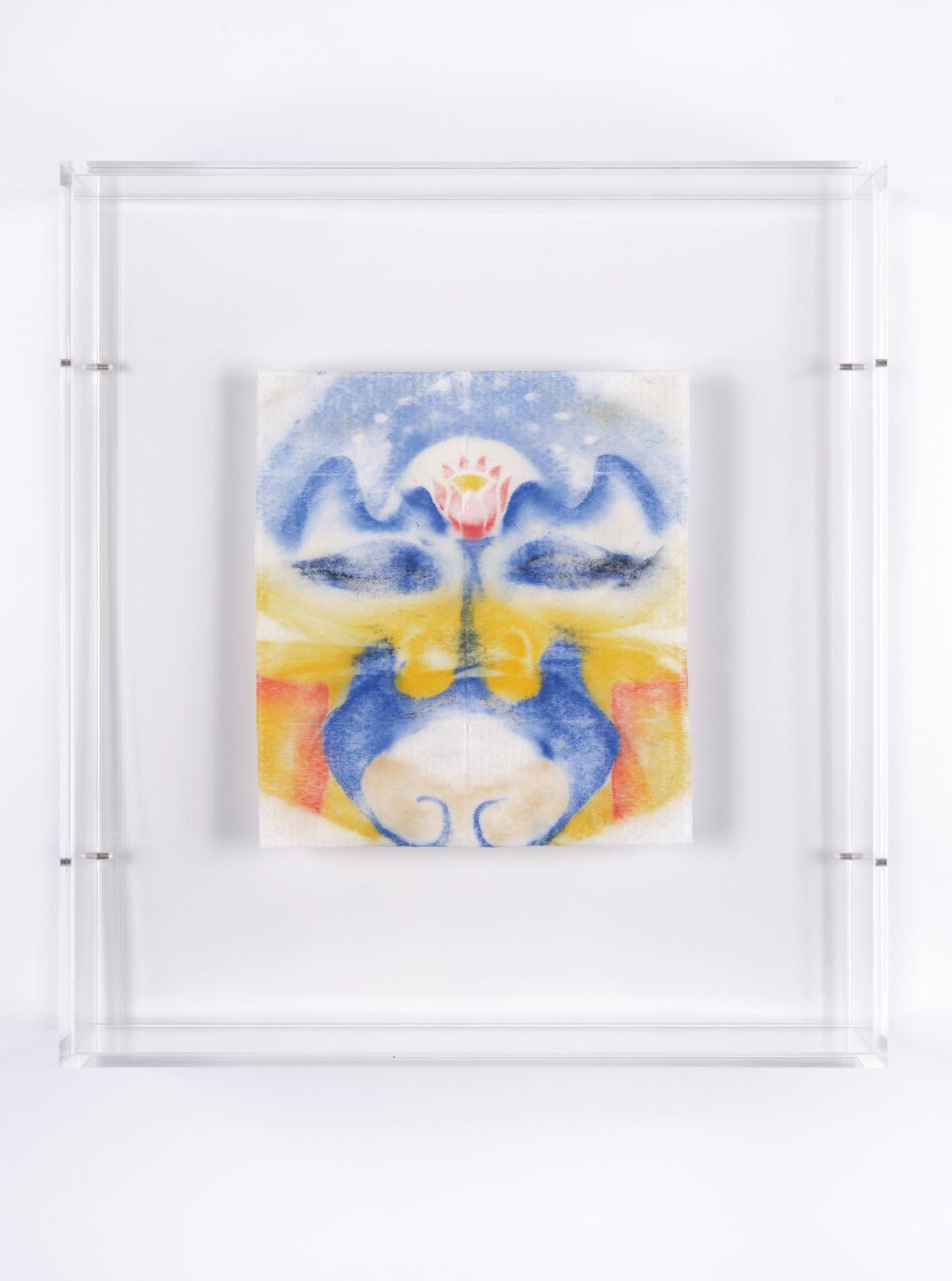
《The Universe Reflected》 2021 年
化妝品,面紙本 20.5 × 17.5 厘米 34.5 × 31.5 × 8.5 厘米(裝裱尺寸)
L
It’s Always You Signed Poster (The Storyteller), 2021 UV cured ink on poster paper, acrylic ink, acrylic box

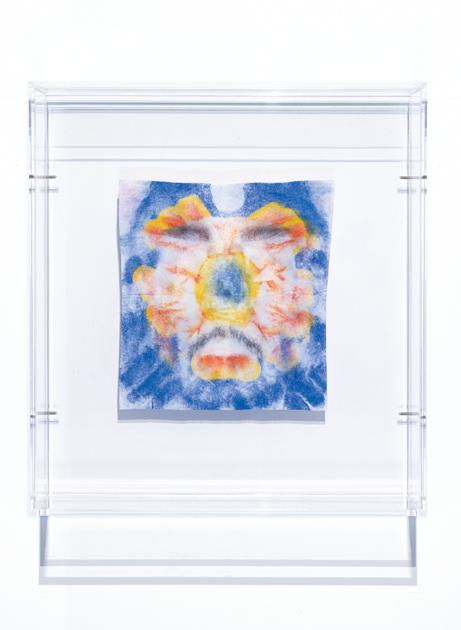
86.5 × 61.5 × 4.8 cm
Ed. 2/6 + 2AP
《It’s Always You Signed Poster(The Storyteller)》 2021 年
UV 印刷、海報紙本、塑料彩、亞克力盒
86.5 × 61.5 × 4.8 厘米(裝裱尺寸)
版本:2/6 + 2AP
R
The Story He Performed, 2021 Makeup on face wipe
20.5 × 17.5 cm 34.5 × 31.5 × 8.5 cm (framed)
《The Story He Performed》 2021 年 化妝品、面紙本
20.5 × 17.5 厘米 34.5 × 31.5 × 8.5 厘米(裝裱尺寸)
L
It’s Always You Signed Poster (The One), 2021 UV cured ink on poster paper, acrylic ink, acrylic box

86.5 × 61.5 × 4.8 cm (framed) Ed. 2/6 + 2AP
《It’s Always You Signed Poster(The One)》 2021 年
UV 印刷、海報紙本、塑料彩、亞克力盒
86.5 × 61.5 × 4.8 厘米(裝裱尺寸) 版本:2/6 + 2AP
R
The One in Me, 2021 Makeup on face wipe 20.5 × 17.5 cm 34.5 × 31.5 × 8.5 cm (framed)
《The One in Me》 2021 年 化妝品,面紙本 20.5 × 17.5 厘米 34.5 × 31.5 × 8.5 厘米(裝裱尺寸)

It’s Always You Signed Poster (Wai King), 2021 UV cured ink on poster paper, acrylic ink, acrylic box 86.5 × 61.5 × 4.8 cm (framed)
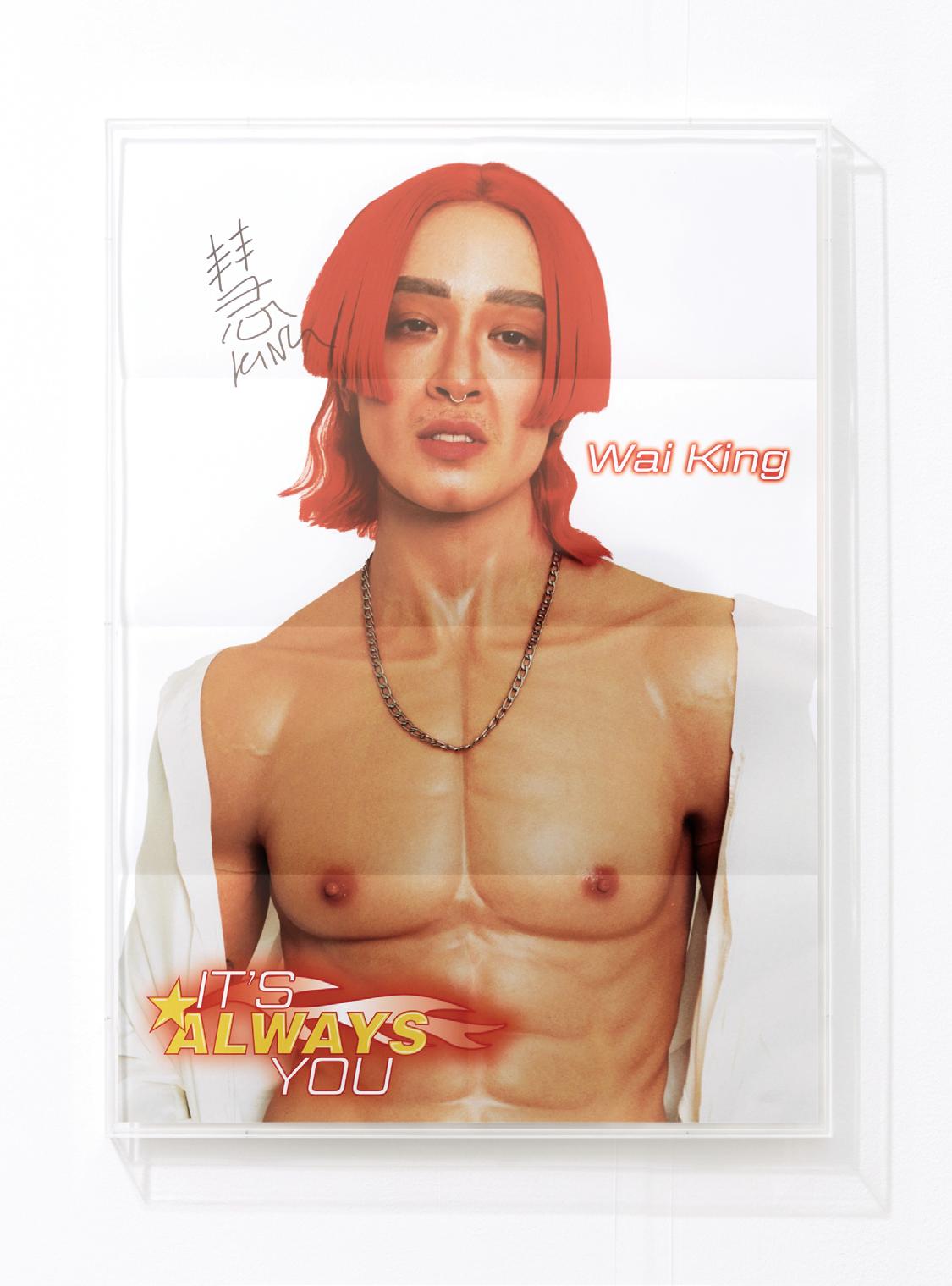
Ed. 2/6 + 2AP
《It’s Always You Signed Poster(Wai King)》 2021 年 UV 印刷、塑料彩、海報紙本、亞克力盒 86.5 × 61.5 × 4.8 厘米(裝裱尺寸) 版本:2/6 + 2AP
Man Behind the Mask, 2021 Makeup on face wipe 20.5 × 17.5 cm 34.5 × 31.5 × 8.5 cm (framed)
《Man Behind the Mask》 2021 年 化妝品,面紙本 20.5 × 17.5 厘米 34.5 × 31.5 × 8.5 厘米(裝裱尺寸)

It’s Always You Signed Poster (Collective), 2021 UV cured ink on poster paper, acrylic ink, acrylic box 86.5 × 61.5 × 4.8 cm Ed. 2/6 + 2AP
《It’s Always You Signed Poster (Collective)》 2021 年 UV 印刷、塑料彩、海報紙本、亞克力盒 86.5 × 61.5 × 4.8 厘米(裝裱尺寸) 版本:2/6 + 2AP



She loved the wrong person every time Inevitable in every relationship To face the future shall she get over it or continue waiting Reflected in the mirror at late night is Someone confused who is drenched in tears I ask myself if this is me?
Couldn't understand why I always hope for a heart-to-heart every time I poured my heart out yet they are all failures In the vastness of life, I am all alone to ask who would like to be born for love, and become wounded all over again Drifting around, dreams never come true
I looked down in front of the mirror at midnight Overwhelmed by guilt
Starring Hong Kong singer and actress Amanda Lee and Singaporean drag queen Vanda Miss Joaquim, Queens (Director’s Cut) by Green Mok explores drag queen-diva worship and daughter-mother relationship in parallel, impli cating the ongoing geopolitical tensions and identity politics in contemporary Hong Kong. In the video, Mok intensifies the obscurity and blurs the dream vs reality and on- vs off-screen dichotomy by playing with mise en abyme, in terweaving the diva, drag queen, and the mother’s fantastical and uncanny dreamscapes. Similar to the fate of Hong Kong’s entertainment industry where the Golden Era of local popular culture has long gone, Veronica (portrayed by Amanda Lee) faces her career decline of becoming a has-been celebrity, worrying about being replaced by a young female idol from mainland China. Simultaneously in a symbiotic yet manipulative daughter-mother relationship, Veronica is entrapped in a labyrinth of anxiety, confusion, and helplessness. Only when she encounters drag queen Vanda (played by Vanda Miss Joaquim), who is a die-hard fan of Veronica, does she get a sense of déjà vu, falling into a warped time loop full of eccentricity and desire for intimacy. Vanda’s further attempt to embody and become Veronica is not merely a deep level of iden tification—her worship eventually develops into a form of queer melancholia where the drag queen internalises the ‘object of desire’ and becomes the diva. This intense level of embodiment alludes to how one endeavours to safeguard the remainder of Hongkongness amidst the present-day socio-political turbu lence. On the other hand, nevertheless, the theatrical, artificial performativity of drag simultaneously bursts this imaginative bubble, beneath all is but a dream with impossible desire and frustration. By synthesising celebrity worship, drag, trauma, and multi-layered identification, Mok’s work invites the viewer to reimagine and queer the identity politics in Hong Kong.
莫育權 的《絲絲(導演版)》由香港歌手兼演員李蕙敏和新加坡變裝皇后 Vanda Miss Joaquim 領銜主演。作品同時並置、探索歌姬崇拜與母女關係,暗指當代香港的身份 認同以及持續動盪的地緣政治關係。藝術家在作品中運用戲中戲的手法模糊夢境與現 實、戲裡與戲外的界限,並交疊編結流行天后、變裝皇后與母親撲朔迷離的夢境。女 明星 Veronica(李蕙敏飾)的事業漸入低谷,面臨被年輕內地女星取替的危機,呼應 早已消逝的本地流行文化黃金時期,象徵了香港娛樂圈的衰退。同時間, Veronica 深 陷既互依又充滿操縱的母女關係當中,在焦慮、困惑與無助的迷宮中掙扎求存。當她 遇上作為 Veronica 忠實粉絲的變裝皇后 Vanda( Vanda Miss Joaquim 飾),她忽然
Born in 1987 in Hong Kong; lives and works in Hong Kong 1987
Green Mok is a filmmaker based in Hong Kong. He is currently pur suing an MFA degree in creative media at City University. His works mostly focus on gender issues. His first short film, The Dragon and Phoenix Show (2012), was awarded and screened at numerous film festivals. He has won the Best Screenplay Awards of Micro film Production Support Scheme (Music) two years in a row for The Drifter (2019) and Queens (2020). Recently, his photography series, Dancing in the dark: a certain time at certain places (2021) and The Drifting -TranSonger Music Video Project (2021) has been exhibited in art galleries and festivals. His latest short film The Moonlight Is Shining Tonight (2022) has been shortlisted for the 27th ifva awards–open category.


Jonalyn Macalalad Molina ’s painting refers to the culture and history of Santacruzan, a religio-historical beauty pageant held across cities in the Philippines during the month of May, celebrating local traditions of youth, love, and romance. In the festival, the pageant honours the finding of the True Cross by Helena of Constantinople, mother of Constantine the Great. For the community of the Filipino diaspora, this annual event even consti tutes their identity. Molina first paints the Catholic church and flower arcs in vibrant, joyous colours restaging the festive backdrop. She then replaces Queen Helena and Prince Constantine with half-Spanish, half-Filipina ac tress Marian Rivera-Dantes and her son Jose Sixto G. Dantes IV. The Filipina community idolises Rivera-Dantes as a Madonna figure, perceiving her as the ideal woman that has it all—feminine beauty, with a successful career, and a perfect family. Such identification reveals the problematic mimicry of Euro-American-centric ideals of beauty in the Philippines. By intertwining Filipino festivals and celebrity worship, Molina examines how cultural practices and ideologies instilled during the Spanish colonial rule are sustained in con temporary Philippines from a racialised, gendered postcolonial perspective.
Jonalyn Macalalad Molina 的畫作涉及五月花節的文化及歷史。五月花節是一年一 度於菲律賓各大城市舉行的選美比賽,具宗教歷史意義之餘亦是當地歌頌靑春、愛情 與浪漫的慶典。此節慶旨在紀念君士坦提烏斯一世之母海倫娜發現眞十字架;對於菲 律賓僑民來說更是其身份認同的重要部分。藝術家首先以鮮明、使人喜悅的色彩繪出 天主教堂及花環,重構具節日氣氛的背景。其後,她以西班牙菲律賓混血女星 Mari an Rivera-Dantes 及其兒子 Jose Sixto G. Dantes 四世代替海倫娜皇后與君士坦提 烏斯一世的角色。菲律賓女性社群崇拜 Rivera-Dantes 為「聖母」,視她作女性的完美 典範——美貌、事業、家庭一應俱全。此等膜拜揭示了菲律賓模仿歐美審美意識型態 的爭議。藝術家連結菲律賓節日傳統與明星追捧,並以帶有種族和性別濾鏡的後殖民 視角發掘西班牙殖民時期灌輸的習俗與意識形態如何仍影響當今的菲律賓社會文化。
Born in 1989 in Calauan, Laguna; lives and works in Hong Kong
Jonalyn Macalalad Molina’s journey to becoming an artist began in the Philippines. At Dayap National High School in 2004, she acquired a non-formal education in fine arts. She then earned an undergraduate degree in Information and Communication Tech nology at Laguna University. After arriving in Hong Kong for work in 2016, she resumed drawing during her free time, specialising in portraiture, flowers, and pet portraits. For Molina, painting is a means to cherish precious moments in life and to combat her loneliness in a foreign city. She was motivated by her new work place to research new methods using internet tutorials. Molina’s mediums now include graphite pencils, charcoal, colored pencils, soft pastels, oil pastels, markers, watercolour, and acrylic. She joined Guhit Kulay in 2019. Her artwork has been displayed in Tamawan Village in the Philippines (2022). She is currently working on a video and animation project with senior lecturer and artist Justyna Kabala from the University of Arts in London.
Santacruzan, 2022 Acrylic on canvas 101.6 × 76.2 cm
Photo: Felix S.C. Wong
Courtesy of the artist Commissioned by Para Site for this exhibition
《五月花節選美》 2022 年 布面丙烯 101.6 × 76.2 厘米
攝影:黃思聰 由藝術家提供
受 Para Site 委託為是次展覽製作
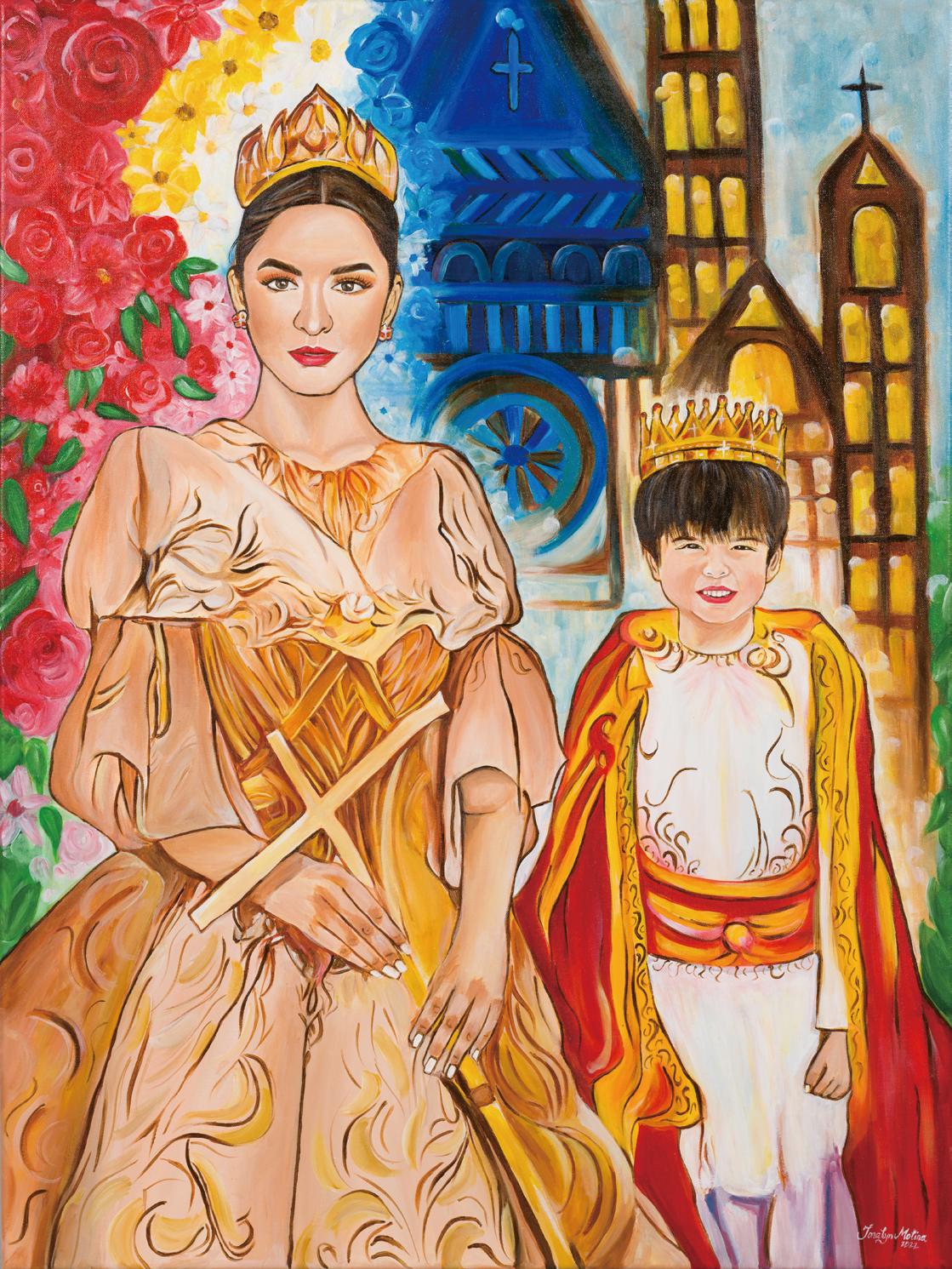
Marilyn Santiago Lopez’s installation depicts one of the largest Catholic gath erings in Quiapo, Manila, where masses of devoted worshippers join the Black Nazerene’s parade and attempt to touch the Jesus Christ sculpture, believing it can miraculously cure sickness and bring blessings. The religious object, made in mesquite wood and carved by an anonymous Mexican artist, is a lifesized work depicting a dark-skinned Jesus Christ kneeling down and carrying the cross. Brought to the Philippines in 1606 from Mexico, it was one of the colonial objects of the Spaniards that travelled between colonies during the Manila Galleon Trade. An interesting feature of the work is that to protect the sculpture originated from Acapulco, Mexico, the authorities replicate two Nazarenes—one with the heads and hands of the original, one with the original torso connecting copies of detached parts. Reflecting on the intersection of Spanish colonisation and religious fanaticism, as well as being sceptical of the sculpture’s widely believed omnipotence, Lopez parodies the festival in a satire and comical fashion. The artist first accentuates the theatricality of the reli gious rite by placing the set of work on a customised pedestal, as if capturing the climax of the fanatical event. She then restages the ritual with miniature figures made of papier-mâché surrounding or climbing up on the wagon to desperately touch the religious sculpture. The artist also creates the Black Nazarene sculpture with detachable body parts, highlighting that the object of worship is not archetypal, and questioning the credibility of religious devo tees’ fanatical illusions.
Marilyn Santiago Lopez 的裝置描繪了馬尼拉奎阿坡其中最大型的天主教聚會之一; 大量虔誠信徒聚集參加黑拿撒勒人的遊行,並試圖觸摸耶穌基督的雕塑,篤信它可以 奇蹟般地治癒疾病及帶來祝福。此宗教物件由一位匿名的墨西哥藝術家以牧豆樹木雕 刻而成,描繪一位跪下、背着十字架的黑皮膚耶穌基督。雕塑於 1606 年從墨西哥帶 到菲律賓,亦是西班牙商隊在馬尼拉大帆船貿易期間穿梭於不同殖民地的物件之一。 作品擁有其中一個有趣的特徵;為了保護起源於墨西哥阿卡普高的雕像,當局複製了 兩個拿撒勒人——一個帶有原物的頭和手,另一個帶有原本軀幹並連接被複製的分離 部分。 Lopez 反思西班牙殖民時期和宗教狂熱的關係,以及對雕塑被普遍認為擁有無 窮力量持懷疑態度,以諷刺和詼諧的方式模仿這個節日。藝術家首先將這組作品放在 一個訂製的底座上,以此強調宗教儀式的戲劇性,彷如捕捉狂熱事件的白熱化片刻。 隨後,她用混凝紙漿創作圍繞或爬上馬車的微型人物,重新上演信徒不顧一切地觸摸 耶穌基督雕塑的儀式。藝術家還設計了擁有可分離身體部位的黑拿撒勒人雕塑,強調 崇拜的對象並非原物,質疑虔誠的宗教信徒的狂熱幻想的可信度。
Born in 1984 in City of Valenzuela, Manila; lives and works in Hong Kong 1984 年生於馬尼拉;現居住並工作於香港
Marilyn Santiago Lopez is a self-taught visual artist. She has worked as a domestic helper in Hong Kong since July 2014. She decided to resume her interest in calligraphy and sketching from her teen age years in 2015. She uses her artistic expression to combat the monotony of her overseas employment. Oil paint, acrylic, oil pastel, graphite, charcoal, watercolour, resin, clay, and coloured pencil are Lopez's main mediums of choice. Her works are at the inter section of realism and modernity. She is one of the members of Guhit Kulay, the migrant artist collective in Hong Kong founded in May 2017. Lopez took part in the Kamustahan Art Project, a global web initiative supported by the British Council (2021). Her works were exhibited at Tam-awan Village (2022); PMQ, Hong Kong (2019), Philippines Consulate General, Hong Kong (2019), and NIDO Asia, Hong Kong (2019). She is now working with Justyna Kabala, Senior Lecturer at the University of Arts, London, on a film and animation project. Additionally, she has been actively engaged in the ongo ing collaboration with the Lensational Programme at the University of Hong Kong.
The Feast of Black Nazarene, 2022
Paper clay sculpture: Paper pulp, wall putty, flour, gypsum powder
Pedestal: Acrylic, resin, newspaper, metal wires, foil, wall putty, gypsum powder
70 × 70 × 54 cm
Photo: Felix S.C. Wong
Courtesy of the artist Commissioned by Para Site for this exhibition
《黑拿撒勒人瞻禮日》 2022 年 紙黏土雕塑:紙漿、油灰、麵粉、石膏粉 底座:亞克力、樹脂、報紙、金屬絲、箔、 油灰、石膏粉 70 × 70 × 54 厘米 攝影:黃思聰 由藝術家提供 受 Para Site 委託為是次展覽製作

You have been killed a thousand times And have been lying in the pit for a long time But in the warfares of people The shamans are rising again The shaman’s are rising In the fields and factories Trying to stop the curse of the past The shamans are rising The call of desperation for a thousand times The tied arm trying to loosen And to every woman wishing for freedom The shamans spirit are rising
Maria Christina Castillo Anire’s painting addresses the psychological conflict of Filipino communities stemming from the contradiction of Western religious and indigenous shamanistic beliefs. Before the Spaniards brought over new prac tices and institutions from their earlier colonial experiences in Latin America to the Philippines, there were shamans, commonly known as babaylan, in various ethnic groups across precolonial Philippine islands. Only when the colonial empire discounted shamanism as witchery and indoctrinated indigenous people with Catholicism was the local community forced to abandon their traditional beliefs. Despite many Filipinos being devout Catholics, they continue to man ifest diverse forms of shamanism and turn to modern faith healers, herbal doctors, and witchcraft. This reveals an attempt to attain equilibrium or a tug of war between two ‘fandoms’, where the Filipino community worships the colonial ideals and simultaneously identifies with shamanistic beliefs. Anire’s work illustrates such power dynamics by depicting the babaylan performing healing rituals in a domestic environment, with Catholic objects and symbols such as the Virgin Mary figurines and the Holy Cross on the shelves in the back ground. The work primarily looks to destigmatise shamanistic practices in the Philippines. More importantly, it proposes an embrace of spiritual rituals of daily life as a mundane way of resisting deep-rooted colonial ideologies.
Maria Christina Castillo Anire 的畫作探討菲律賓社群在西方宗教與原住民薩滿信仰 的矛盾關係之下的心理衝突。西班牙人將較早前在拉丁美洲實行的殖民策略帶到菲律 賓;在此之前,菲律賓群島的諸多族裔群體均有被稱為「巴巴蘭」的薩滿師。殖民帝國 視薩滿教為巫術,並對原住民灌輸天主教信仰,使當地社群不得不摒棄其傳統信仰。 雖然眾多菲律賓人為虔誠天主教徒,他們仍繼續信仰草藥治療以及巫術等薩滿傳統。
這揭示了兩種崇拜之間,在嘗試找到平衡過程中的角力——菲律賓社群在崇尙殖民理 想的同時,也在薩滿信仰之中獲得身份認同。藝術家在一個居家環境裡描繪出這種權 力關係——一位「巴巴蘭」薩滿師正在進行療癒儀式;背景裡可見聖母瑪利亞像與十字 架等天主教象徵。作品旨在為菲律賓的薩滿實踐去除污名;更重要的是,作品提倡接 納日常生活中的精神儀式,從而在日常對抗根深蒂固的殖民主義意識形態。
Born in 1985 in the City of Catbalogan, Samar; works and lives in Hong Kong
Maria Christina Castillo Anire received her degree in Civil Engineer ing, and began working as a domestic helper in Hong Kong in 2012. Anire is a self-taught visual artist and employs mixed media in her artistic practice, including oil pastel, soft pastel, acrylic, oil paint, watercolour, marker, pencil, and charcoal. She views her diversi fied photography as a way to capture and preserve her treasured memories, and believes art has the meditative curing potential of connecting souls and relieving tensions. Anire has completed the EmpowerU Programme at the University of Hong Kong (2018–19) and the Lensational Beginner’s/Intermediate Programme. In 2018, she joined the migrant artists’ group, Guhit Kulay. Her works were exhibited in Tam-awan Village (2022); and 480.0 Gender & Art Space (2020), Philippine Consulate General (2019), Lumenvisum Gallery (2019), and NIDO Asia (2018) in Hong Kong. She is currently working on an animated film project with fellow migrant workers led by Justyna Kabala, Senior Lecturer at the University of Arts, London.
Babaylan -The Healer Shaman, 2022 Acrylic on canvas 101.6 × 76.2 cm
Photo: Felix S.C. Wong
Courtesy of the artist Commissioned by Para Site for this exhibition
《巴巴蘭——巫醫》 2022 年 布面丙烯 101.6 × 76.2 厘米
攝影:黃思聰 由藝術家提供
受 Para Site 委託為是次展覽製作

have been killed a thousand times
have been lying in the pit for a long time
in the warfares of people The shamans are rising again The shaman’s are rising In the fields and factories Trying to stop the curse of the past
shamans are rising The call of desperation for a thousand times
tied arm trying to loosen
to every woman wishing for freedom The shamans spirit are rising
The textile work by Cristina Balao-as Cayat shifts the viewer’s focus from criticising how western colonisers are destroying the traditional heritage of the colonised, to how the worshipping of superior figures within indigenous communities may also lead to similar irreversible repercussions. With Benguet heritage, Cayat has been researching the interrelationship between the mi gration history of the Imbosi tribal members and the loss of body tattoo art. Based on scant historical records, the artist realised that on one occasion the floor collapsed during a peshit (the largest community gathering); since the incident, the mankutom (a wealthy and respected male figure) in the commu nity professed that bad omens were lingering in the entire tribe. To get rid of bad luck, he made the tribe leave Imbosi and their culture behind, promising a far-from-ideal grand vision that they would be able to pursue greatness and prosperity in a new place. To address this lesser-known precolonial history, the artist first rips the Benguet woven fabric apart and embroiders thirteen human figures on the organza as distorted Benguet tattoo designs, which represents the thirteen barangays (the smallest administrative division in the Philippines) of Kabayan, the centre of Benguet culture. With the tattoos seemingly perish ing from the fabric’s rift, which symbolises the death of full body tattoo art forms, Cayat’s work wishes to evoke the audience’s awareness on how submis sive idolisation could eradicate critical cultural heritage.
Cristina Balao-as Cayat 的紡織作品嘗試轉移觀眾的批判角度,從評論西方殖民者 如何破壞被殖民者的傳統遺產,到觀察土著社區中對尊者的崇拜也可導致類似的不可 逆轉的後果。 Cayat 遵循本格特省的傳統,一直致力研究 Imbosi 部落成員的遷移歷 史與紋身藝術沒落的關係。藝術家翻查僅餘的歷史紀錄後,發現在一次社區聚會中, 地面不幸坍塌;這次意外後,社區中一位富有且受人尊敬的男人( mankutom )宣稱 不祥之兆正散播於整個部落。為了驅散厄運,他慫恿部落離開 Imbosi 並遺棄他們的 文化傳統,並向他們承諾在新的國度追求繁榮和偉大。為了呈現這段鮮為人知的前殖 民歷史,藝術家首先撕開本格特布料,隨後在柯根紗上繡上十三個人物,代表着被扭曲 的本格特紋身圖案。這些圖案象徵了作為本格特省文化中心的城市 Kabayan 的十三 個行政分區。紋身設計似乎在布料的裂縫之間逐漸消逝,意味着全身紋身藝術文化的 殞落。 Cayat 希望觀眾能夠意識盲目崇拜偶像可導致文化遺產面臨危機甚至被根絕。
Born in 1974 in City of Baguio; lives and works in Hong Kong
Cristina Balao-as Cayat is a self-taught artist and the co-founder of Guhit Kulay. In 2017 she started to use acrylic, graphite, and watercolour as her main art medium. Besides employing exist ing objects as the subject matter, her recent interest in weaving materials has led her to include woven fabrics and threads in her practice. Her art, which centres on the idea of ‘host nation’, is a synthesis of her Filipino cultural heritage and her experiences in both the Philippines and Hong Kong. She has taken part in a num ber of projects and exhibitions, such as ‘Tahi-tagning Pagsibol’, a collaboration with Alma Quinto at NCCA Gallery, Manila (2022); ‘Kumustahan Art Projects’ (2021); ‘Obra: Sining at Galing nga mga Megranting Pilipino’, Philippine Consulate General, Hong Kong (2019); ‘Day Off Mo?’, Collaboration with Alma Quinto at Centre for Heritage Arts and Textile, The Mills, Hong Kong (2019); and ‘Beyond Myself—Enrich HK’, Hong Kong (2018). Cristina Balao-as Cayat 是一位素人藝術家及菲律賓藝術機構
Kulay 的共同創辦人。她於
Lost in Oblivion, 2022
Handwoven fabric, organza, gold colour thread, wooden pole 176.5 × 68.5 cm
Photo: Felix S.C. Wong
Courtesy of the artist Commissioned by Para Site for this exhibition
《迷失於遺忘之間》 2022 年
手工編織、柯根紗、金線、木棍
176.5 × 68.5 厘米
攝影:黃思聰
由藝術家提供
受 Para Site 委託為是次展覽製作

America Bridge will remain, even though I have left Tokyo. After that, whenever I think of you, the sound of the Yamanote Line lingers.
In the window of the last train, numerous faces of you appeared and disappeared in the trembles.
do not hate you anymore
understand you The bridge that offers adulthood, which In this very season, you always walk across unconsciously.
BuBu de la Madeleine and Yoshiko Shimada collaborated in 1998 to produce the series Made in Occupied Japan, which comprises etching, photographic collages, and video performance, to investigate the history of postwar Japan under American occupation. In Portrait, Shimada and de la Madeleine got in drag and respectively became a U.S. occupation soldier and Japanese military sex worker. Shedding light on a rarely publicly discussed sexual subtext, the artists problematise Japan’s mimicry of American culture by intersecting the exoticisation of Japanese women during World War II and the postwar peri od, as well as the patriarchal power structure of Japanese society. 1945 also explores the close economic and military relations and dependencies between the two countries in a similar vein. In Portrait, the artists re-enact the famous photograph of Japanese Emperor Hirohito and the American General Douglas MacArthur. The latter initiated political and economic reform and put it in force in 1947, and one of the most significant changes includes abolishing the Em peror’s political authority and demolishing his godly status. The artists parody such a historical moment by surrounding the photograph with a heart cush ion, alluding to a controversial portrayal of the power relations between two nations as an arranged marriage. By employing drag to stage both peripheral and centralised narratives of postwar Japan, Shimada and de la Madeleine’s works blur the man vs woman, U.S. vs Japan, and perpetrator vs victim binaries and mirror the ardent Japan-United States geopolitical relations that are still lingering as of today.
布布 · 哆 · 拉 · 瑪德蓮娜 與 嶋田美子 在 1998 年共同創作了《據日製造》系列,通過蝕刻 版畫、攝影拼貼畫與表演錄像的組合,研究二戰後以美國為首的同盟國軍事佔領日本 時期的歷史。在作品《肖像》中,藝術家透過變裝分別扮演了美國同盟軍軍人和日本 軍妓。藝術家交織二戰期間和戰後被異國情調化的日本女人與日本社會的父權結構, 映照鮮少被公開討論、帶有性暗示的議題,從而責問戰後日本對美國文化的模仿。 《 1945 》在相似的脈絡中延續對於兩國經濟與軍事依賴關係的探索。作品中,藝術家重 新演繹日本昭和天皇與美國道格拉斯 · 麥克阿瑟將軍( Douglas MacArthur)的著名合 照。麥克阿瑟將軍於 1947 年在戰後日本實施政治與軍事重組,其中最為重要的改變 包括廢除天皇的政治權威和廢除其神聖地位。兩位藝術家以嘲諷手法將記載此歷史時 刻的照片鑲嵌在一個紅色的愛心枕頭中,爭議地影射美日兩國之間的權力關係為包辦 婚姻。嶋田與哆 · 拉 · 瑪德蓮娜的作品運用變裝,上演戰後日本被邊緣化和中心的敘事,
BuBu de la Madeleine joined the artist collective Dumb Type and appeared in their performance ‘S/N’ (1994–96), subsequently re leasing her own works in various media. Around the same time, she committed herself to civil movements related to health and human rights such as people living with HIV and AIDS, and sex workers. She has also performed as a drag queen at clubs. She has participated in group exhibitions at Arts Maebashi, Gunma (2019); Kyoto Seika University (2010); and University of Brighton (2001). She received her BA in concept and media planning from Kyoto City University of Arts.
Yoshiko Shimada is a proponent of feminist-informed art in Japan. Her artworks reflect on cultural memory—including Past Imperfect (1991–93), which examines Japanese women’s roles during the war as both victims and perpetrators; Comfort women/women of Conformity (1994–97) which juxtaposed women's roles in Japan and other Asian countries; Made in Occupied Japan (1998–2000), which looks at military bases as sites for sex, violence, and power. In exploring legacies of war and occupation, Shimada proposes a practice of feminist artmaking as a tool for self-examination, and to complicate the victim vs oppressor binary. Working with me diums such as printmaking, performance, and video installations, Shimada invokes pathos and conversations about the state of affairs in the past and the present. Her art was on display recently at Garage Museum of Contemporary Art, Moscow (2021–22); Aichi Triennale (2019); and Tel Aviv University Art Gallery (2015). She cur rently lectures on feminism and art at the University of Tokyo.
Portrait, 1998
Collage
24.8 × 32.9 cm 47.2 × 35.1 × 2.1 cm (framed)
《肖像》 1998 年
拼貼畫 24.8 × 32.9 厘米 47.2 × 35.1 × 2.1 厘米(裝裱尺寸)
R
L 1945, 1998

Collage
50.8 × 50 cm 91 × 91 × 3.5 cm (framed) 《1945》 1998 年
拼貼畫 50.8 × 50 厘米 91 × 91 × 3.5 厘米(裝裱尺寸)
All works courtesy of the artist and Ota Fine Arts, Tokyo 所有作品由藝術家和大田秀則畫廊(東京)提供

U.S.A.
The Twist dance floor (floor, floor) U.S.A.
The mirror ball I fell in love (love, love) U.S.A.
In my friend’s vintage open car (open car, open car) U.S.A.
The girl's hair fluttered (fluttered, fluttered)
Flying across the Pacific Ocean in one jump
The heart is always in the First Class
Exchange glasses of dreams
Make a promise to love and peace
C'mon, baby America
Successful friend organiser
C'mon, baby America
Brings new waves from the West Coast
C'mon, baby America
Every night is also a day
baby America
So they unite in one sunrise
The selected works by Yasumasa Morimura showcase the artist’s use of drag, props, and digital manipulation to transform himself into iconic figures and images from Western cultural canon. From the artist’s perspective, the 20th century was an excess of conflict, destruction, war, and a world of blood, sweat, and tears. In his Self Portrait/Actress series from the 1990s, Morimura poses as some of the most renowned actresses, such as Marlene Dietrich, Audrey Hepburn, Marilyn Monroe, Greta Garbo, Ingrid Bergman, and Brigitte Bardot, and restages iconic scenes from emblematic moments of the Hollywood golden era. Each celebrity embodies a fragment of Japanese desires, and ostensibly represents Japan’s fandom of American pop culture, but also a postwar culture of mimicry that reveals their increasingly intertwined economic, military, and political power. There are two other works by Morimura that offer an alternate perspective on Japan’s identification with the West. Adjacent to the photo graphs is the video Season of Passion/A Requiem: MISHIMA, where the artist reenacts Japanese author Yukio Mishima’s failed coup in 1970. As a contro versial Japanese nationalist figure, he argued that Japan had become ‘eternal slaves of foreign culture’, and committed public suicide after the coup speech. The artist occasionally freezes certain frames in the video so the audience can examine the political fanatic’s facial expressions. Opposite these works is the one referring to Japanese actress Wakao Ayako in Irezumi (The Spider Tattoo) (1966). Ayako plays a femme fatale who is sold to a geisha house. Branded with a spider tattoo, she turned into a ‘black widow’, which evokes her desire to enact revenge on men who have wronged her and regain control over her life. The work plays out a power reversal of gender relations and alludes to how Japan (feminine) continues to subtly seduce and haunt the Western spectator (masculine) in post-war times. Born in 1951 in Osaka; lives and works in Osaka
與淚水的世界。在其 1990 年代的《自拍像 / 女演員》系列作品中,森村喬裝成瑪琳 · 黛 德麗、柯德莉·夏萍、瑪麗蓮·夢露、葛麗泰·嘉寶、英格烈·褒曼、碧姬·芭鐸等知名女星, 繼而重現荷李活黃金年代的標誌性場景。作品中每位女星代表着零碎的日式情慾,看 似呈現日本對美國流行文化的追捧,同時亦象徵日本在戰後對美國文化的效法,以致 兩國的經濟、軍事與政治角力愈發緊密。森村其餘兩件這次展出的作品,則提供了另
Ever since Yasumasa Morimura created his self-portrait photograph in 1985, disguising himself as Van Gogh in one of his self-portrait paintings, the artist has incessantly produced ‘self-portrait-like art works’ where he transforms himself into ‘others’ beyond time, race, and gender. While maintaining his practice to become someone other than himself, the artist gazes at the indisputable fact that he is still himself and continues to question its meaning. Understand ing both the contemporary and historical framework and inserting his own analysis of others, their artistic achievements and historical memories, Morimura continues to employ his own body as well as photography, video, and performance into his art practice, which has influenced many. Selected solo exhibitions include those at Kyoto City KYOCERA Museum of Art (2022); Artizon Museum, Tokyo (2021); Hara Museum of Contemporary Art, Tokyo (2020, 2013); Japan Society, New York (2018); Pushkin Museum, Moscow (2017); National Museum of Art, Osaka (2016); The Andy Warhol Museum, Pittsburgh (2014); and Shiseido Gallery, Tokyo (2013). Selected publications: Whereabouts of self-portrait (2019); What is beauti ful? Recommendation on art (2011); and Lecture on the anatomy of art (2001). He opened his own museum, M@M, in Osaka in 2018.
錄像和行為,影響了許多藝術家。他曾於京都京瓷美術館(2022 年)、 東京 Artizon 美術館(2021 年)、東京原美術館(2020 、2013 年)、紐約 日本協會(2018 年)、莫斯科普希金造型藝術博物館(2017 年)、大阪國 立國際美術館(2016 年)、匹茲堡安迪沃荷博物館(2014 年)以及東京資 生堂畫廊(2013 年)舉辦個人展覽。精選出版包括《自畫像的下落》(2019 年);《什麼是美?藝術推薦》(2011 年);以及《藝術解剖講座》(2000 年)。 2018 年,他於大阪開辦了自己的博物館—— M@M 。

L
Self Portrait (b/w) After Audrey Hepburn 4, 1996
Gelatin silver print
45 × 30 cm
68.5 × 52 cm (framed) Ed. 1/10
《自拍像(黑白)⁄ 模仿柯德莉 · 夏萍之四》 1996 年 銀鹽印相 45 × 30 厘米 68.5 × 52 厘米(裝裱尺寸) 版本:1/10
M
Self Portrait (b/w) After Greta Garbo 2, 1995

Gelatin silver print, 45 × 36 cm 68.5 × 52 cm (framed) AP 1/2
《自拍像(黑白)⁄ 模仿葛麗泰 · 嘉寶之二》 1995 年 銀鹽印相 45 × 36 厘米 68.5 × 52 厘米(裝裱尺寸) 版本:AP 1/2
R
Self Portrait (b/w) After Brigitte Bardot 4, 1995

Gelatin silver print
45 × 30 cm 68.5 × 52 cm (framed) Ed. 1/10
《M 的自拍像 ⁄ 碧姬 · 芭鐸之四》 1995 年 銀鹽印相 45 × 30 厘米 68.5 × 52 厘米(裝裱尺寸) 版本:1/10
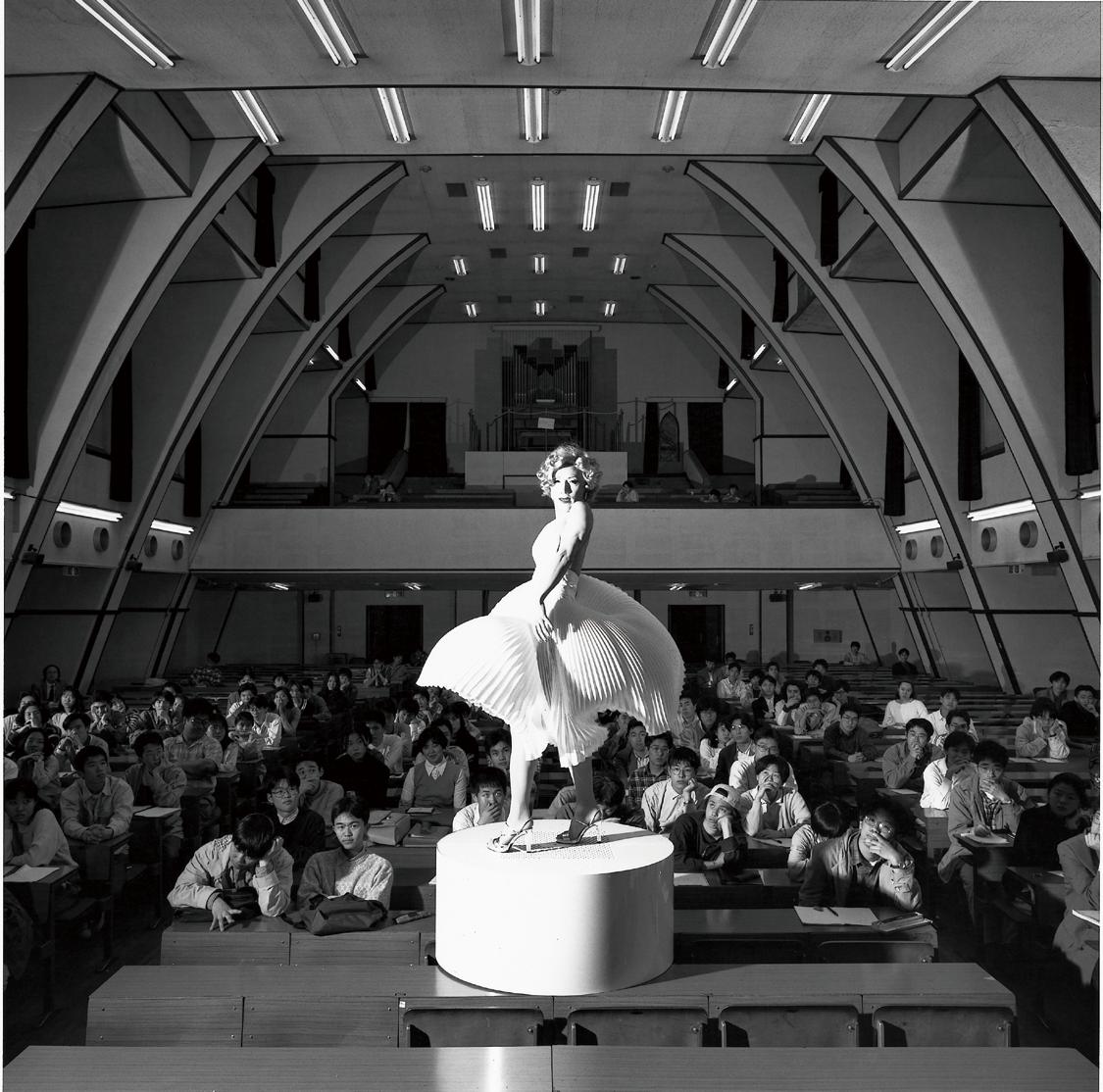

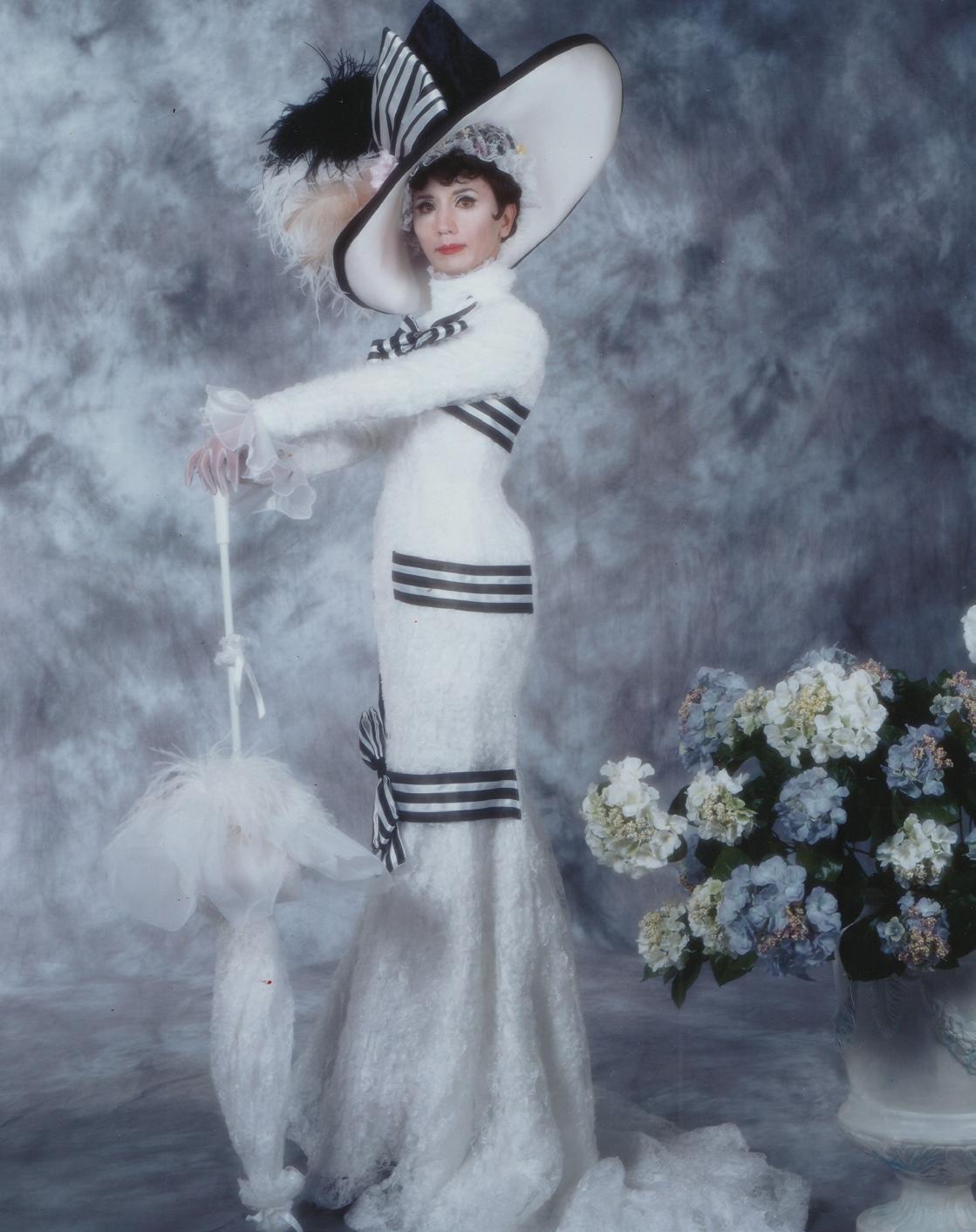
120 × 95 cm (framed) AP 2/2

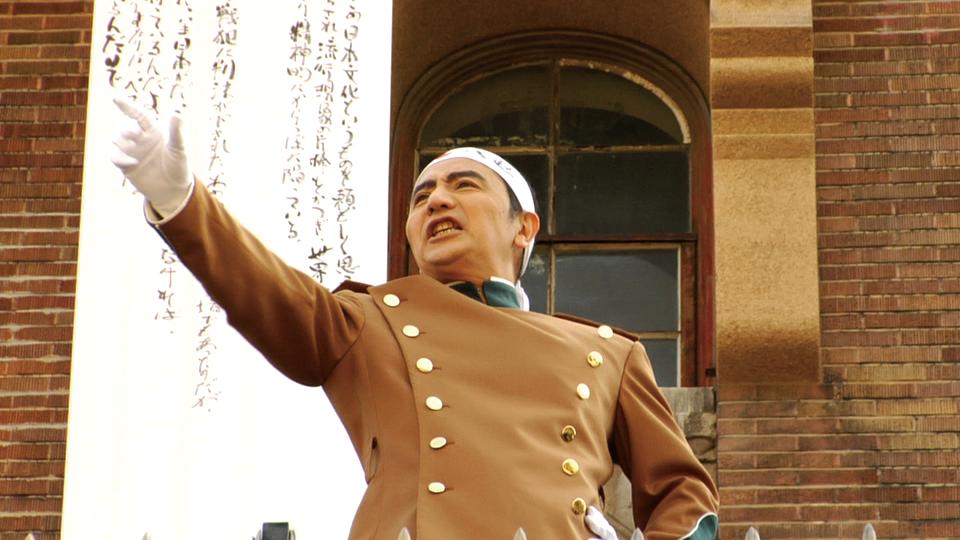

Buried in drama, a lifetime buried in drama
My face is already stiff
One’s life is like acting in innumerable movies
And I am already exhausted from the play
I wish to give up, I wish I could give up
Yet if I may I would never abandon myself
The pressure is so formidable that it fills my heart
Even escaping from the thoughts could be a toiling task
I wish to give up, I wish I could give up
Yet if I may I would never abandon myself
The pressure is so formidable that it fills my heart
Even escaping from the thoughts could be a toiling task
Feeling dazed, today I can not remember anything Has the past ever left?
Ho Tzu Nyen’s The Nameless is a video collage that synthesises a fragmentary and multi-layered narrative that studies the nature of storytelling, memories, and identity in postcolonial Southeast Asia. The persona ‘Nameless’ is based on Lai Teck, one of the fifty known aliases of the Secretary-General of the Malay an Communist Party from 1939 to 1947. Before being killed in Thailand, he was a triple agent who first worked for the French and British secret forces, and finally with the Japanese Kempeitai during the years of the Malaysian Occupation. On a personal level, Ho, as a fan of Tony Leung Chiu-wai, casts the internationally recognized Hong Kong actor in The Nameless as Lai Teck, the legendary spy of Sino-Vietnamese descent. The artist creates the work just as a fan-made video of Leung by splicing scenes from an array of films in the past forty years of the actor’s career, particularly those where he has often been cast as traitors, moles, and informers. The artist especially excerpts footage from Hong Kong cinema, such as In the Mood for Love (Wong Kar Wai, 2000), Lust, Caution (Ang Lee, 2007), and The Grandmaster (Wong Kar Wai, 2013). In these films, Leung portrays characters who lived in volatile and shifting times, like when Japan invaded China and Hong Kong in the 1930s and 40s, or when Mainland Chinese immigrants flooded 1960s Hong Kong for its rapid economic growth under Brit ish rule. The dual-channel video is showcased in a symmetrical configuration across two rooms. The spatial design enables the audience to hear overlapping Chinese and Vietnamese voiceovers, and to view the other side through a black scrim screen. Ho guides the audience to interpret the work on three levels— Lai Teck’s mysterious biography, Tony Leung’s roles in the referenced films, and Leung as a Hong Kong actor. The entwinement of these identities and frag mented voices reveals how editing and reassembling can fabricate one’s mem ories and perceptions of history and larger-than-life figures. Presented in an ambitious format, The Nameless is a self-reflexive video work that prompts the viewers to question the nature of identity and resist existing representations in the grand narrative of Southeast and East Asian geopolitics.
Lai Teck )—— 1939 至 1947 年間馬拉西亞共產黨總書記的五十個化名之一。他在泰國被殺之前,曾為三重間 諜,先後效力法國及英國的秘密組織,最後在馬來西亞日佔時期效忠憲兵隊。在個人
Born in 1976 in Singapore; lives and works in Singapore 1976
ABOUT THE ARTIST 藝術家簡介
Ho Tzu Nyen makes films, installations, and performances that begin as engagements with historical and theoretical texts. His recent works are populated by metamorphic figures such as the weretiger and the triple agent, under the rubric of The Critical Dictionary of Southeast Asia, an ongoing meta project. Solo exhibitions of his work have been held at the Toyota Municipal Museum of Art (2021); the Yamaguchi Centre for Arts and Media (2021); Edith-Russ-Haus for Media Art, Oldenburg ( 2019); Kunstverein, Hamburg (2018); Ming Contemporary Art Museum, Shanghai (2018); Asia Art Archive, Hong Kong (2017); Guggenheim Bilbao (2015), and Mori Art Museum, Tokyo (2012). He represented the Singapore Pavilion at the 54th Venice Biennale (2011). Recent group exhibitions include the 13th Gwangju Biennale (2021), Aichi Triennale (2019) and ‘2 or 3 Tigers’ at the Haus der Kulturen der Welt (Berlin, 2017). Together with Taiwanese artist Hsu Chia-Wei, he co-curated the 7th Asian Art Biennial (2019) at the National Taiwan Museum of Fine Arts. Ho was awarded a DAAD Scholarship in Berlin (2014–2015) and the Grand Prize of the Asia Pacific Breweries Foundation Signature Art Prize (2015).
2021 年)、歐登堡 Edith-Russ-Haus 多媒體藝術中心(2019 年)、 漢堡藝術協會(2018 年)、上海明當代美術館(2018 年)、香港亞洲藝術 文獻庫(2017 年)、畢爾包古根漢美術館(2015 年)和東京森美術館(2012 年)。此外,何氏曾代表新加坡參加 2011 年第 54 屆威尼斯雙年展。其 近期群展包括第 13 屆光州雙年展(2021 年)、愛知三年展(2019 年)以 及柏林世界文化宮的「兩或三隻老虎」(2017 年)。他與台灣藝術家許家維 共同策劃了國立台灣美術館第七屆亞洲藝術雙年展「來自山與海的異人 」 (2019 年)。何子彥獲得柏林 DAAD 獎學金(2014 至 2015 年)和亞太釀 酒集團基金會標誌藝術大獎(2015 年)。
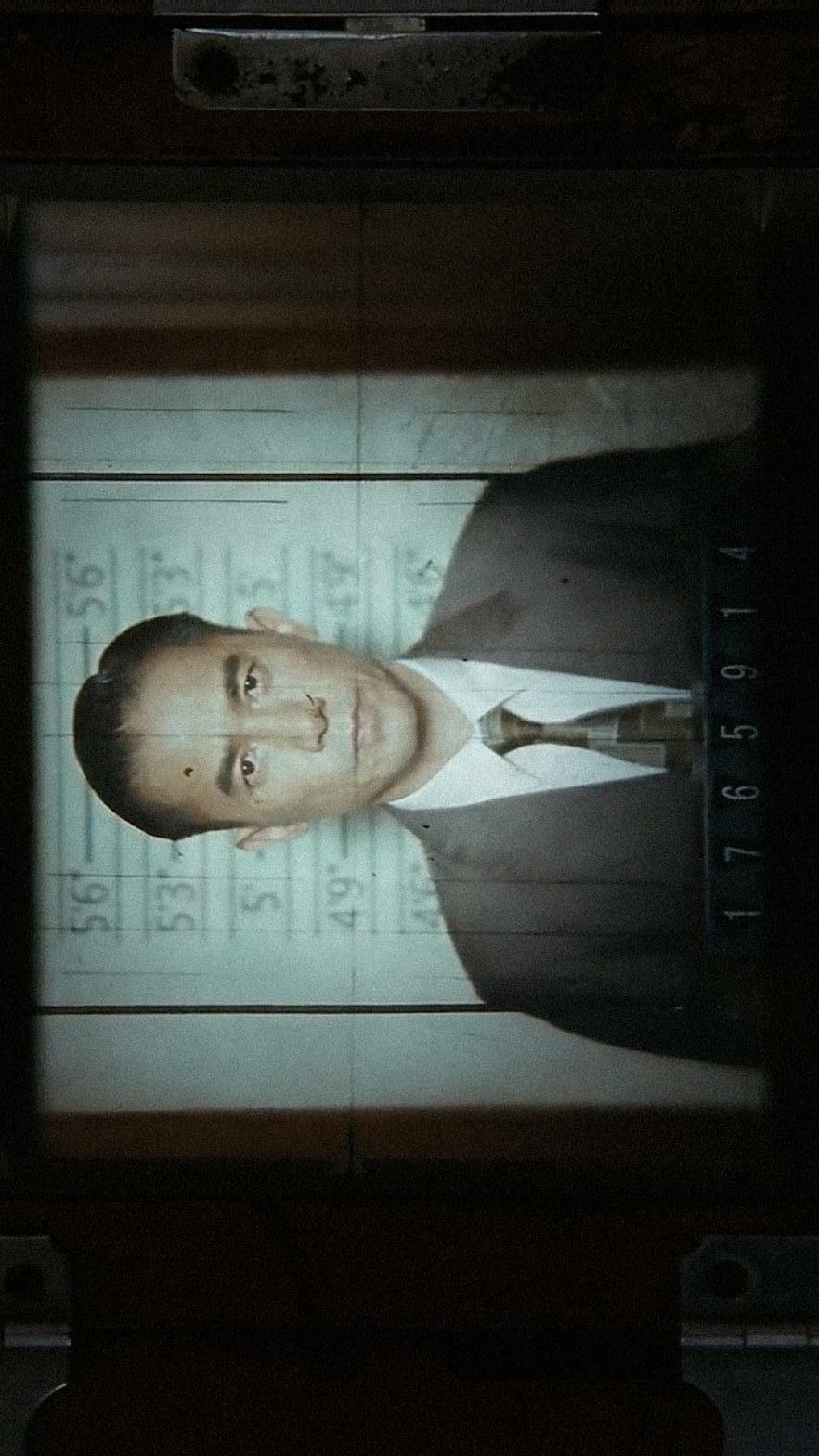

I wanted to tell you about my hard times despite they could only be heard after they vanished Close your eyes Feel my fluttering heart, and the way I gaze at you Please don’t wait for any miracles There’s a rough road in front of our sight With unknown obstacles and a future that can’t be anticipated I can’t change, I can’t give up
Please protect me with your unconditional love Even if it is for my broken heart No words are needed when looking into your eyes Time has frozen
Yuree Kensaku samples and remixes surrealist art, meme culture, fan art, and animation to present a contemporary commentary on Thai socio-political landscapes. In Democrazy (2022), the artist uses the new governor of Bangkok Chadchart Sittipunt who won the election in May 2022 as the subject matter. The younger generation portrays Sittipunt as the strongest person on the planet, as he was seen walking barefoot on the street casually into a Buddhist temple as the Minister of Transport in Thailand in 2013. The photograph went viral as an internet meme, gaining him the nickname ‘The World’s Strongest Minister’ in local media. Kensaku translates this idea by depicting Sittipunt as Kenshiro from ‘Fist of the North Star’ kissing a Kaiju, which is a giant monster with an omnipresent, evil, and indestructible force that features in Japanese tokusatsu entertainment. The artist further references The Lover (1928) by René Magritte, in which a man and a woman kiss with a veil over their heads. The fabric becomes a barrier that prevents the intimate embrace of two lovers, transforming a passionate act into frustrated desires. This thought-provoking imagery uncannily reminds Kensaku of those who were perceived as a threat by the Junta, including Sittipunt, who have been forcefully transported to an unknown ‘re-education camp’ with bags over their heads eight years ago. Painting a hero kissing a villain with bags over their heads, the artist prompts the viewers to reflect over the complex interrelationship of contemporary poli tics, collective memory, trauma, and popular culture.
寺的畫面在網絡瘋傳,被傳媒稱為「全世界最強大的部長」。藝術家將西提潘描繪成漫 畫《北斗神拳》的拳四郎( Kenshiro ),同時親吻着「怪獸」( Kaiju )——日本特攝影 視中邪惡、難以擊敗的怪物。藝術家進一步指涉雷尼 · 馬格列特( René Magritte )的 《戀人》(The Lovers,1928 年)畫中一男一女以白布蒙頭做出親吻的動作。布料成 為親密的障礙,將熱情化作受挫的慾望。此情景使藝術家聯想到八年前軍政府逮捕了 被視為威脅的異見人士(包括西提潘在內),他們不單被布袋蒙頭,更被押往「再教育」 營。藝術家藉着英雄與反派蒙面親吻的畫面,逼使觀者思考當代政治、集體回憶、創 傷與流行文化之間難以釐淸的轇轕。
THE ARTIST 藝術家簡介
Yuree Kensaku is a Japanese-Thai multidisciplinary artist whose works are known for their electrifying colours, rich sense of humour, and sugar-coated cartoon characters with a dark twist. Wildly entertaining at first glance, Kensaku’s works persistently present bold, critical commentary on society, as well as intimate introspection on her personal life as a female artist. After grad uating from the Department of Visual Arts, Bangkok University, in 2002, her works were presented in various solo and group exhibitions. She held a solo exhibition at Centre Intermondes, La Rochelle, France (2020) and Yokohama Museum of Art (2007) as artist-in-residence. She participated in Hawaii Triennale (2022); Bangkok Art Biennale (2021); Thailand Biennale (2018); the 4th Moscow Biennale for Young Art at the Museum of Moscow (2014); and Kuandu Biennale, Taipei (2010). Her works are included in the permanent collections of Mori Art Museum, Singapore Art Museum, Yokohama Museum of Art, and MAIIAM Contemporary Art Museum.

Democrazy, 2022
Acrylic, glitter and collage on canvas
120 × 160 cm (120 × 80 cm each)
Photo: Aroon Permpoonsophon
Courtesy of the artist Commissioned by Para Site for this exhibition
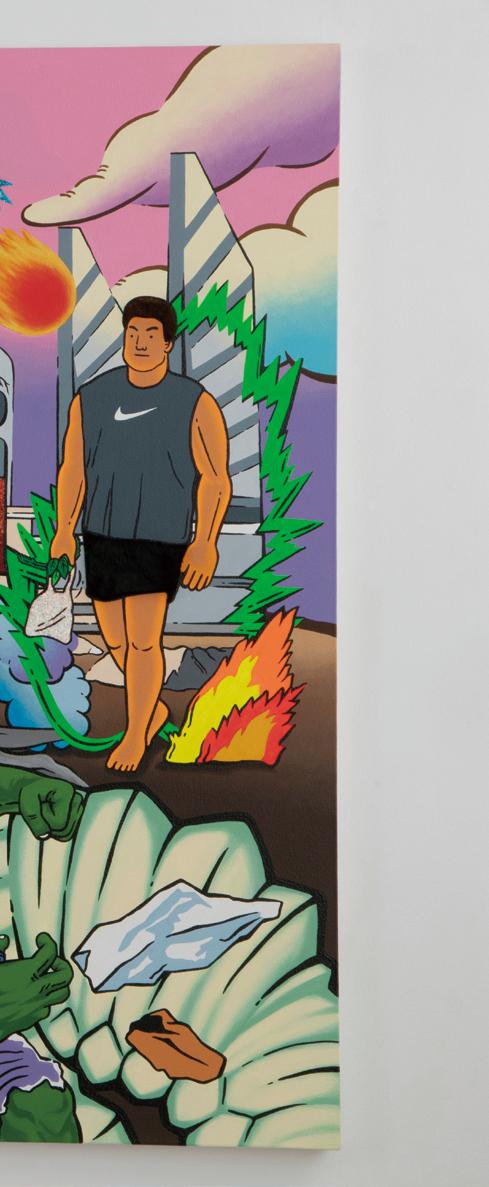
《民主狂熱》 2022 年
布面丙烯、閃粉及拼貼畫 120 × 160 厘米(每幅 120 × 80 厘米)
攝影:Aroon Permpoonsophon 由藝術家提供
受 Para Site 委託為是次展覽製作
II'm happy No, I’m happy alright? Since I receive your love I'll be happy to death Even if there are cracks in my sculpted body Yeah, I think it's easier to lose me than to lose you I want to be madly loved Even if I know I'm your sculpture Even in the pain that I have breaking apart It's okay, I'm your sculpture Your sculpture Your sculpture Your sculpture
Haneyl Choi has been exploring the potential of a sculptor by creating works in trailblaz ing and experimental forms and mediums that challenge the conventional framework of fine art sculpture-making. In Move, Common dream: Be a great IDOL, Choi applies such critique in the context of the South Korean entertainment industry, infamous for its controversial and exploitative factory-like production of idols. Idols are trained to attain an absurd level of perfection in music videos and public performances that resembles the choreographic synchronisation in North Korea's mass game. Under such a manipulative system they are mechanised and transformed from three-dimensional human beings into singular, homogeneous images. Choi perceives the idols’ deprivation of agency as becoming ‘living sculptures’—objectified subjects with no ego. To envision a new definition and form of idols, Choi creates a sculpture idol group by referencing and deconstructing representative and groundbreaking pieces by modern sculptors such as Alexander Calder, Isa Genzken, Kim Chung Sook, Robert Morris, and Richard Serra. Different from K-pop idols, these artists wish to bring animation into their works by introducing pioneering techniques, integrating sculptures and performance art, discerning nuanced relationships between sculpture, space, and architecture, and questioning the concept of sculpture with a postmodern twist. In Choi’s perspective, these modernist sculptors produce mobile and kinetic works that highlight the other connotation of ‘living sculpture’—sculptures with vitality. This set of works, where each sculpture is nicknamed after the aforementioned modern sculptors (with one excep tion that is after the artist’s nickname in real life), reveals how the artist interweaves his ardour in sculpture practices with his reflection on the modern-day construction and fabrication of K-pop idols. Choi also presents STOP, Common dream: Be a great MAN, a sculpture consisting of a metal stand with hundreds of idol group keychains. During the exhibition period, the idols who have become commodified, hyper-flat fan merchan dise are available for the viewers to take home as souvenirs, eventually leaving an emp ty stand in the space. Choi sets up this sarcastic presentation to accentuate how K-pop idols are ultimately objectified images circulating as capital in the libidinal economy.
Born in 1991 in Seoul; lives and works in Seoul 1991
Haneyl Choi explores sculpture’s formative potential as a narrative framework, yielding symbolic configurations of individuals, arche types, and sites of encounter that engage multiple visual perspec tives and elicit indeterminate interpretations. The ambiguity that pervades Choi’s oeuvre informs his ongoing inquiry into sculpture’s expressive potential as both signifier and signified, and bespeaks his critical stance toward identity politics, consumer culture, normative social structures, and postmodern discourse in contem porary art. His work has been included in group exhibitions at Ilmin Museum of Art, Seoul (2020); Asia Culture Center, Gwangju (2020); and National Museum of Modern and Contemporary Art, Gwacheon (2019). He participated in the 10th Seoul Mediacity Biennale (2018) and was a resident at Seoul Art Space Geumcheon in 2019. Choi received his BFA in sculpture from Seoul National University and MFA from Korea National University of Arts. Haneyl Choi


Genz, 2022
Plaster with antenna, 3D print 150 × 120 × 130 cm
《Genz》 2022 年 石膏、天線、3D 打印 150 × 120 × 130 厘米
Willy, 2022
Sponge, fake fur 50 × 50 × 185 cm
《Willy》 2022 年 海綿、假毛皮 50 × 50 × 185 厘米
Sooky, 2022
Styrofoam with epoxy, chrome on FRP 75 × 57 × 210 cm

《Sooky》 2022 年 聚苯乙烯泡沫塑膠、環氧樹脂、鉻、 纖維強化塑膠
75 × 57 × 210 厘米
Serra, 2022
Steel, acrylic bar 62 × 37 × 150 cm
《Serra》 2022 年 鋼,丙烯條 62 × 37 × 150 厘米
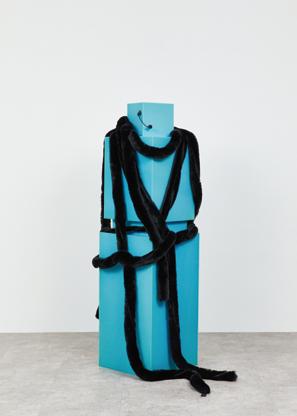
Alexa, 2022
Plywood, bronze pipe and bar 223 × 171 × 12.5 cm



《Alexa》 2022 年 膠合板、靑銅管和棒材 223 × 171 × 12.5 厘米
Photo: Joe Sunghyun
Courtesy of the artist and P21, Seoul Commissioned by Para Site for this exhibition 攝影:Joe Sunghyun 由藝術家及 P21 畫廊(首爾)提供 受 Para Site 委託為是次展覽製作
With the support of Ministry of Culture, Sports & Tourism of Korea, Korea Arts Management Service, and the grant program Fund for Korean Art Abroad
獲韓國文化體育觀光部,韓國藝術管理服務及海外韓 國藝術撥款計劃資助
STOP, Common dream: Be a great MAN, 2022 Acrylic keychain, steel stand Dimensions variable

Forever young boy so we ride or die You and I ride endlessly Under the red sunset you are by my side Pinked out or murdered out like it ain’t no
We need nothing, we are the protagonists Say life’s a bitch? But mine’s a movie Like my diamond, we’ll shine together Whenever wherever forever ever ever Thrillingly, more dangerously Will you go to the ends of the world, let’s go Now let go Let’s have no regrets when today has gone by So that time can’t tear us apart So that this moment can be eternal You light a fire in my heart So that my youth without regret is on fire I’m not afraid of anything tonight I could die in this moment
Forever young (young, young)
BLACKPINK is the revolution (revolution, revolution)
Diane Severin Nguyen’s If Revolution is a Sickness employs the vernacular of K-pop to crystallise Vietnamese diasporic experiences in Eastern Europe, mapping a wider cross-pollination across nations that are influenced by Cold War era political allegiances. The first half of the video is a melodrama that depicts an orphaned Vietnamese child growing up in Warsaw, Poland. It also consists of narration in Polish and Vietnamese voiceovers that unfold writings on revolution by Ulrike Meinhof, Hanna Arendt, and Mao Zedong, among others. The female protagonist (played by Weronika Nguyen) then joins a Polish K-pop dance crew. Scouted by the artist on Instagram, the lead actress has the combination of a common feminine Polish name with Nguyen’s Vietnamese family name, acting as the anchor point that embodies the complex diasporic history between the two nations, both with socialist influences. The accumulated internal affective tension then leads to the second half of the work, which is presented as a music video with melodies and lyrics co-written by Nguyen, and featuring a crew of teenaged Polish K-pop dancers performing original choreography. The artist channels personal traumas experienced by diasporic communities and the misunderstood younger generation through the communal power of music. The video is showcased in a monumental yet intimate space. Using blood red, mustard yellow, and milk white hues, the design deconstructs Polish and Viet namese flags to further abstract and dissolve geopolitical borders between East and West, echoing Nguyen’s use of K-pop to interconnect nations with shared histories. Together with adolescent K-pop lovers worldwide, Nguyen calls for an international revolution to emancipate the ‘forever young’ by inviting them to dance the pain away and ‘shoot at the enemy with diamonds’. 阮心藍 的作品《如果革命是一種病》運用韓國流行樂的詞彙聚焦東歐越南僑民的經 歷,藉此勾勒受冷戰時期政治影響的各國之間藕斷絲連的關係。錄像前半段劇情豐 富,講述一個在波蘭華沙長大的越南裔孤兒的故事。波蘭語及越南語的旁白呈現烏 爾麗克 · 邁因霍夫( Ulrike Meinhof)、漢娜 · 萼蘭( Hanna Arendt)、毛澤東等人關 於革命的著作。女主角( Weronika Nguyen 飾)這時加入了一個波蘭韓國流行樂舞 團。藝術家於 Instagram 物色女主角,同時擁有波蘭女子的首名以及與藝術家相 同的越南姓氏「阮」,成為兩個社會主義歷史的國家之間牽絆的化身。上述累積的情 感張力在作品後半部以音樂錄像的姿態現身,由藝術家參與作曲作詞,以及一眾波 蘭靑年表演原創韓國流行樂舞步。藝術家利用音樂的凝聚力,傳達僑民社群以及備 受誤解的年輕一族飽受的身心創傷。錄像作品展出於一個既顯赫又私密的空間。空 間設計運用血紅、芥黃與乳白色調,以抽象方式解構波蘭與越南的國旗,進一步消
Born in 1990 in Carson; lives and works in New York 1990 年生於卡森;現居住並工作於紐約
Diane Severin Nguyen is an artist who works with photography, video, and installation. Her photography hybridises the organic and the synthetic into amalgam sculptures, held together by the parameters of a photographic moment, and her video work expands that moment into a layered cultural and historical con text. She has had solo exhibitions at SculptureCenter, New York (2022); Renaissance Society, Chicago (2022); and Contemporary Art Museum Houston (2022). Nguyen’s films have been screened at Yebisu Festival, Tokyo; IFFR, Rotterdam; Berlinale, Berlin; and New York Film Festival. Recent group exhibitions have been held at 58th Carnegie International, Pittsburgh (2022–2023); ‘GHOST 2565 Trien nial’, Bangkok (2022); Greater New York 2021 at MoMA PS1, New York (2021); Hammer Museum and The Huntington (2020–2021); and ‘Bodies of Water: 13th Shanghai Biennale’, Power Station of Art (2021). Nguyen earned a BA from Virginia Commonwealth University in 2013 and an MFA from Bard College in 2020.
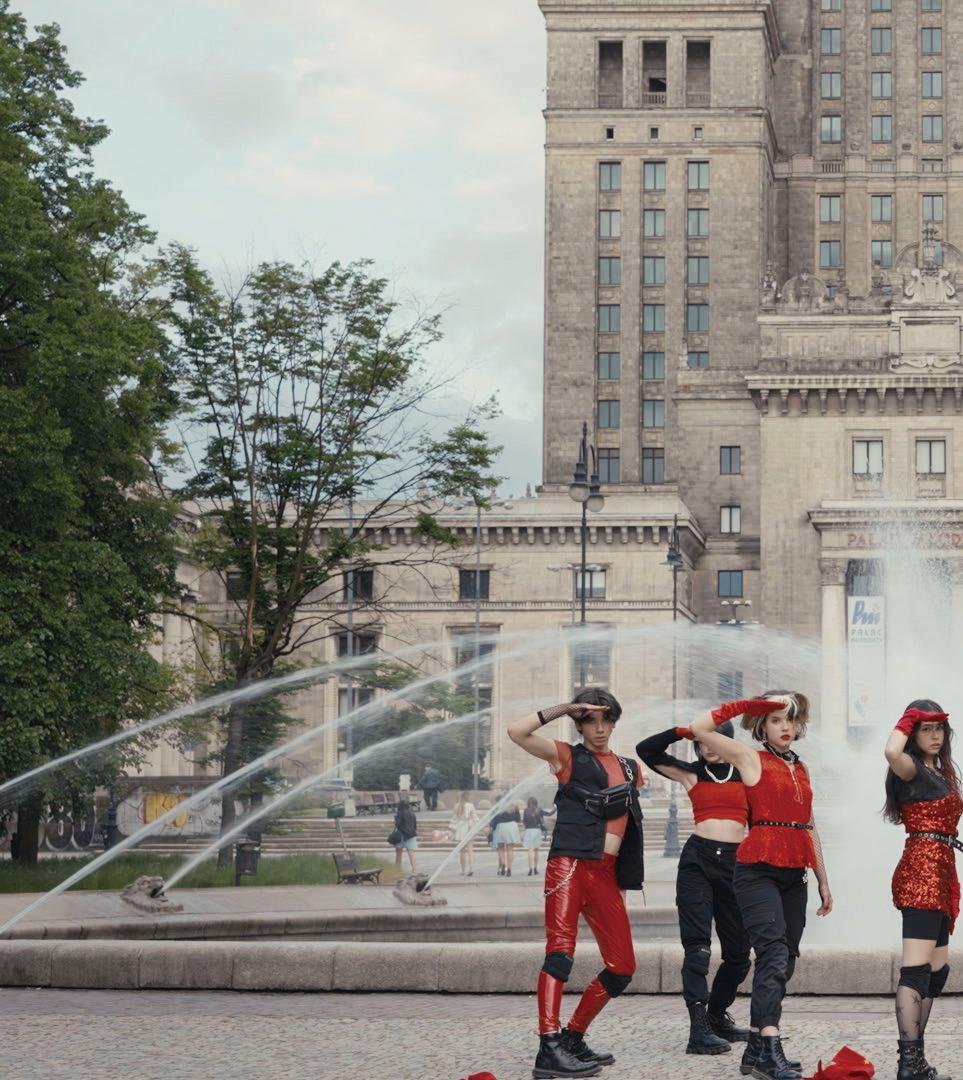
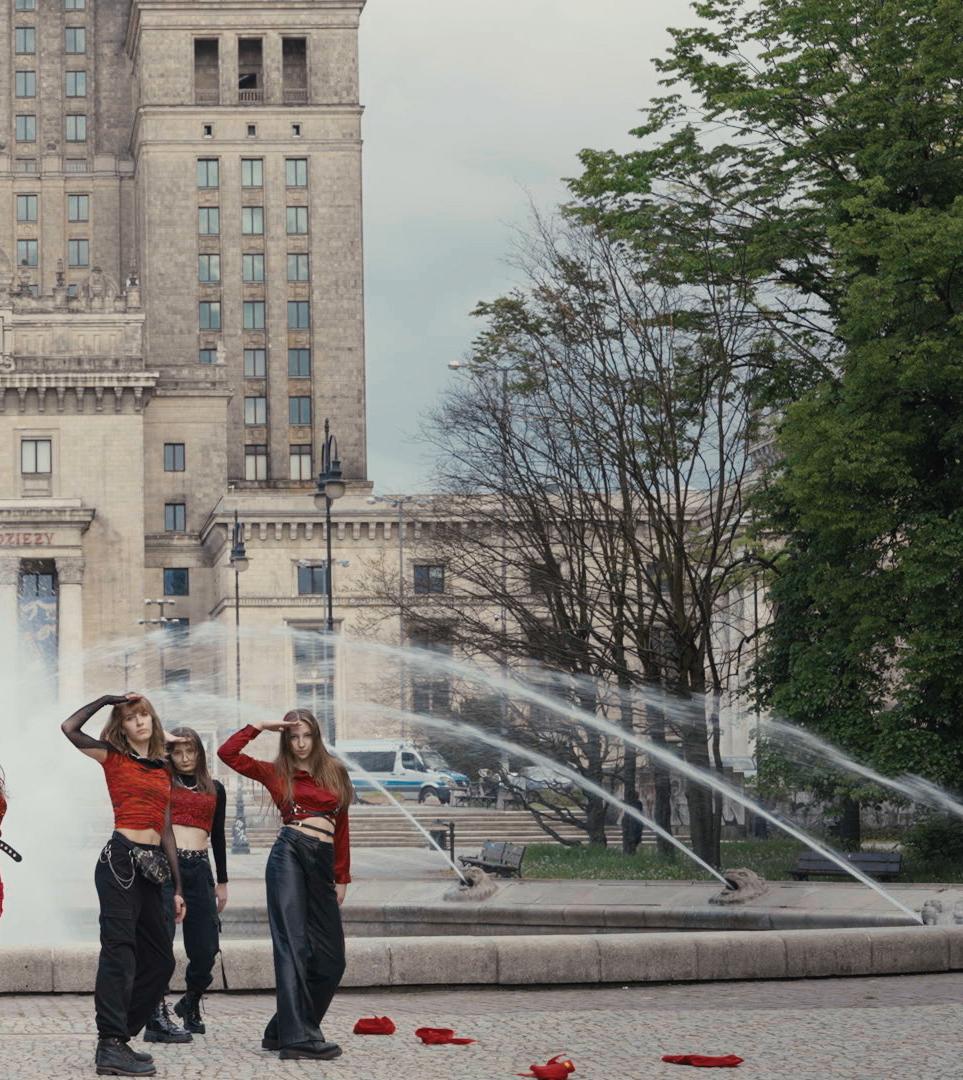
In this moment right now (all, all, all, oh yeah) Light me up with all the lights here and there, look, look, look It’s not dangerous (oh), believe my eyes (oh yeah) You don’t need to put on a worried face I’m telling you, you don’t Do you want to walk in the wide skies? Tell me your true stories The lights have turned on I hope you’ll shine on me from that high place (eh) Um this light that contains warm words so bright The radiating colours ah I can’t stop my exclamations woo
Dew Kim’s interactive installation employs fantastical religious imagery and apocalyptic aesthetics to reinterpret the K-pop concept of ‘ending fairy’. Fans go through a process of cathexis at this zenith, in which they admire how idols overcome the shortness of breath caused by intense choreography. When the idols make eye contact with the camera and present divine expressions and poses, the fans invest an excess of affective capital and view the idols as an ultimate object of desire. Kim believes it has a similar modus operandi to how devotees worship religious iconographies. Many masters in Western art canon have depicted the Ascension and the Second Coming of Jesus Christ. Such works in the Renaissance period glorify and exalt Jesus Christ but also perceives him as the sign of the Apocalypse, an omnipotent and encompassing Other that demands one to revere faithfully and yet to fear him concurrently. Simi larly, the video-shooting techniques and mise-en-scene in K-pop music videos and live performances on stage present the idols as divine, angelic figures with radiating halos. However, against the dystopian backdrop, they are either the root of ‘the Fall’ or ‘the Chosen Ones’ to take over the current world order. Discerning how K-pop fans ambivalently project their desires and anxiety, Kim creates the painting-like installation Enrapture featuring himself as the holy idol amidst the apocalypse. The artist eternalises the ending fairy pose by framing himself in a delicate wood frame and lenticular printing that emulates stained glass windows in religious settings, encapsulating the desire-driven climactic moment in religio-inspired K-pop performances. The audience will also realise a technological, futuristic angel machine named LOOK gazing at them. Confronted by this unknown creature, the viewers are under godly lumi nescence radiating from the LED light ring and see themselves being filtered as an ending fairy by an iPhone. The audience finds themselves becoming their desired object, receiving an overloaded amount of satisfaction yet simultane ously experiencing their utmost fear.
往因此灌注過剩的情感資本 , 並視偶像為終極的慾望對象。藝術家認為這與虔誠信徒 崇拜宗教圖像的動作模式不謀而合。西方藝術經典中不同大師都曾描繪耶穌升天和基 督再臨的情境。這些文藝復興時期的作品一方面頌揚和讚美耶穌基督,同時亦視他為
Born in 1985 in Seoul; lives and works in Seoul 1985
ABOUT THE ARTIST 藝術家簡介
Dew Kim (aka Huh Need-you) explores the meaning of beings excluded from and discarded by the world moving towards normality, and the intense impulsive energy generated therein. He also visualises the queer narrative through the process of self-objectification, and attempts to break the boundaries of social structures and binary thinking. Kim graduated from Konkuk University in Chungju where he studied metalsmithing and jewel lery, and received an MA in sculpture from the Royal College of Art in London. He has had solo exhibitions at Fragment Gallery, Mos cow (2021), TEMI Artist Residency, Daejeon (2019), and Archive Bomm (2018). His work has also been exhibited at documenta 15 (Kassel, 2022), National Museum of Modern and Contemporary Art, Seoul (2022 and 2020); Ilmin Museum of Art (Seoul, 2020); Vereingung bildender Künstlerinnen Österreichs (Vienna, 2020); and Institute of Contemporary Arts, London (2017).
他曾在莫斯科 Fragment Gallery(2021 年)、大田 TEMI 藝術家駐留計 畫(2019 年)和 Archive Bomm(2018 年)舉辦個展。他的作品還曾在 第十五屆卡塞爾文獻展(2022 年)、首爾韓國國立現代美術館(2022 、 2020 年)、一民美術館(首爾, 2020 年)、維也納 VBKÖ(2020 年)和倫 敦當代藝術學院(2017 年)展出。

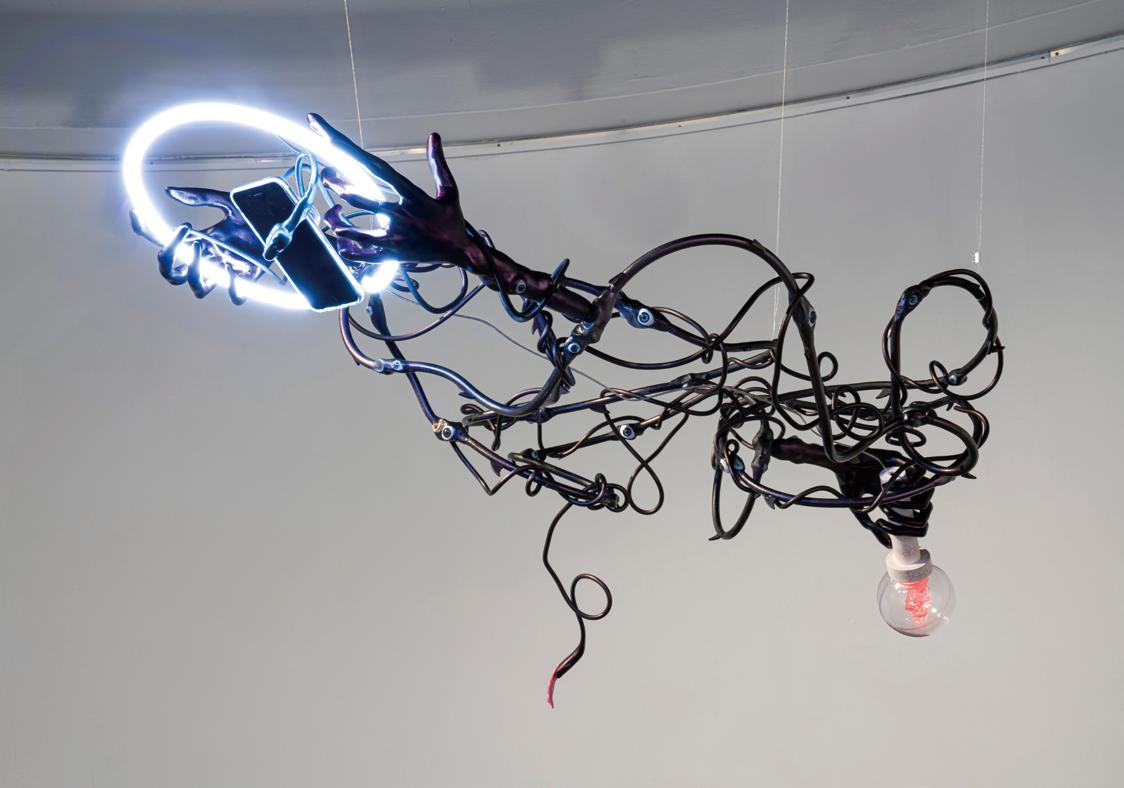
Lu Yang has been applying neurotechnological concepts in his previous artworks to explore the potential of human bodies. Presented in a music video format with video game and animation aesthetics, Electromagnetic Brainology Brain Control Messenger stars Japanese music idol Chanmomo ◎ from the group Band Ja Naimon! as a towering girl warrior called Brain Control Messenger. She is deter mined to defeat all conscious beings with weapons made with modern medical technologies, such as the Deep Brain Stimulation (DBS) crown, the Transcranial Magnetic Stimulation (TMS) magic wands, and an innovative remote-controlled weapon designed with Galvanic Vestibular Stimulation (GVS) technology that enables people to control their walking directions via remotes. The work osten sibly criticises how celebrities are agents of the entertainment industry that ideologically control the masses. However, behind the scenes, Chanmomo ◎ has sardonically participated in a GVS experiment provided by the technology’ s co-developer Osaka University, where she was being controlled and underwent involuntary body movements. By unveiling the idol’s contradictory subjectivity off- and on-screen, and humoristically portraying the ‘frenemy’ dynamic be tween Brain Control Messenger and Brain Monster performing against the dark, eerie pop song backdrop, Lu’s work dismantles the fandom/stardom binary and power dynamic, and underlines how the omnipresent and omnipotent technol ogy exposes human’s transient and fragile existence.
Band Ja Naimon! 的成員 Chanmomo ◎飾演一位名為腦制御士的巨人女戰士。女戰 士決心以現代醫學科技武器打敗所有意識主體,如腦深層電刺激(DBS)皇冠、腦磁 激(TBS)魔杖、以及一種運用前庭電刺激技術(GVS)使人可用遙控器控制他人行走方 向的創新遠程控制武器。作品表面上看似批評明星作為娛樂產業的媒介控制大眾的意識 形態。然而在螢幕背後,Chanmomo ◎本人諷刺地參與了一場由該技術的聯合開發者 大阪大學組織的前庭電刺激實驗;實驗過程中她被控制並經歷非自主的身體移動。陸 揚的作品透過揭露偶像主體在幕前幕後的矛盾,以及在黑暗陰森的流行背景音樂的襯 托下,作品如何幽默地上演腦制御士與腦怪獸之間亦敵亦友的關係,打破了明星與粉 絲的二元和權力關係,凸顯科技的無處不在和全能的特質如何曝露人類短暫而脆弱的 存在。
Born in 1984 in Shanghai; lives and works in Tokyo and Shanghai 1984 年生於上海;現居住並工作於東京及上海
Shanghai-based multimedia artist Lu Yang creates fantastical, often painful, and shocking images which represent an interdis ciplinary blend of religion, philosophy, neuroscience, psychology, and modern technology, as well as allusions to real life forms and structures of natural and religious origins. The output of Lu Yang’s artistic practice spans game engines, 3D-animated films, video game installations, holograms, motion capture performances, virtual reality, and software manipulation. The artist also collaborates with acclaimed scientists, psychologists, performers, designers, exper imental composers, music producers, robotics companies, and pop stars. His work has been featured in major museums and institu tions internationally including solo exhibitions at the ARoS Aarhus Art Museum (2021–2022), Kunstpalais Erlangen (2022), Museum of Contemporary Art Cleveland (2017), Ullens Center for Contemporary Art, Beijing (2012), and Fukuoka Asian Art Museum (2011). Her work has been featured in group exhibitions at international institutions, including at the Venice Biennale (2022 and 2015); Asia Society Triennial, New York (2022); Centre Pompidou, Paris (2020); Shanghai Biennale (2018 and 2012); Liverpool Biennial (2016); Montreal Inter national Digital Art Biennial (2016). Lu Yang was awarded Deutsche Bank's 2022 Artist of the Year and the BMW Art Journey in 2019.
2022 、 2015 年);紐約亞 洲協會三年展(2021 年);巴黎龐畢度藝術中心(2022 年)上海雙年展 (2018 、 2012 年);利物浦雙年展(2016 年);蒙特利爾國際數位藝術 雙年展(2016 年)。陸揚近期得獎包括德意志銀行年度藝術家(2022 年) 和寶馬藝術之旅(2019 年)。

Cusson Cheng is a curator and art critic from Hong Kong. He has been Assistant Curator at Para Site since January 2021, and has curated ‘Fanatic Heart’ (2022) and worked on exhibitions including ‘Minding the G(r)a(s)p’ (2022), ‘Noble Rot’ (2021–2022), ‘Liquid Ground’ (2021), and ‘Curtain’ (2021). He was also one of the candidates for the 2019 Para Site International Conference & Workshops for Emerging Professionals. Besides institutional programs, he was also the guest curator of ‘Retrograde’ (2022) at Galerie du Monde, Hong Kong. In addition to his curatorial work, Cheng serves as Art Editor at the Hong Kong-based leading Chinese-language art periodical Art and Piece ( 美 紙 ). He has interviewed internationally renowned artists, including Marina Abramovi , Rebecca Ackroyd, Oliver Beer, Genieve Figgis, Nicolas Party, and Pipilotti Rist. He is frequently invited by galleries and organisations to lead curator tours and write ex hibition reviews, including ‘Whirlwind: Informel to Gutai’ at Whitestone Gallery, Hong Kong (2022), and Korean artist Lee Bae's solo presentation at Perrotin, Hong Kong (2021). Cheng received his BA with Honours in comparative literature, sociology, and Buddhist studies from the University of Hong Kong.
Para Site is Hong Kong’s leading contemporary art centre and one of the oldest and most active independent art institutions in Asia. It produces exhibitions, publica tions, discursive, and educational projects aimed at forging a critical understanding of local and international phenomena in art and society.

Alongside artist fees to all participating artists, Para Site is offering medical and dental subsidies for Hong Kong artists in the exhibition. 除了參展藝術家薪酬,Para Site 藝術空間為參展的香港藝術家提供醫療和牙科津貼。
Special thanks to all the artists, as well as 特別鳴謝各位藝術家,以及
Blindspot Gallery, Hong Kong 刺點畫廊(香港)
Manie Bootaranark
Kilian Chan 陳鈞量
Sirius Chan 陳詠詩
Kelvin Cheng 鄭耀曦
Soo Choi 崔壽延
Mimi Chun 秦美娜
Sharon Fung 馮思樺
Angela Gao 高澳
Helena Halim 林心儀
Cyan Hong 洪瑞蓮
Emmanuel Tsuwan Hsieh 謝祖望
Scarlett Sijia Huang 黃思嘉
Akane Ikeda 池田茜
Minako Ishii 石井美奈子
Kiang Malingue, Hong Kong 馬凌畫廊(香港)
Maisy Lai 賴敏琦
Aaron Lam Kwok Yam 林國鑫
Kaman Lam 林嘉文
Carmen Lau 劉嘉汶
Kenna Lau 劉曉澄
Sherman Lee 李允嵐
Wesley Lee 李司朗
Harry Leung 梁皓然
Jacqueline Leung 梁婉揚
Louise Leung 梁鳳儀
Wingyee Leung 梁詠怡
Harmish Muszid
Ota Fine Arts, Tokyo 大田秀則畫廊(東京)
Hidenori Ota 大田秀則
Nuchanart Q Ormsby P21, Seoul P21 畫廊(首爾)
Shugo Arts, Tokyo 周吾藝術(東京)
Shugo Satani 佐谷周吾
Sakura Shimizu 淸水櫻
Daehoon Shin 申大訓
Patrick Sun 孫啟越
SUNPRIDE FOUNDATION 驕陽基金會
Hannah Tang 鄧咏珊
Kelly Tang 鄧曉妍
Macy Tse 謝銘思
Wang Xin 王辛
Samantha Wolf
Clara Wong 黃子恩
Holly Wong 黃鉦恩
Wu Lok Hang 胡樂行
Momoko Yamada 山田桃子
Johann Yamin 姚錦榮
Seungwook Yang 梁升昱
Yang Tian 楊添
Seok Hui Yap 葉淑慧 | ARTFACTORY
Miranda Yin 尹依茗
Nick Yu 俞迪祈
Billy Tang 曾明俊
Executive Director / Curator 執行總監 ⁄ 策展人
Kelly Ma 馬元中 Deputy Director 副總監
Celia Ho 何思穎 Curator 策展人
Cusson Cheng 鄭家醇
Project Manager / Assistant Curator 項目經理 ⁄ 助理策展人
Kobe Ko 高穎琳
Project Manager / Assistant Curator 項目經理 ⁄ 助理策展人
Marlene Lieu 呂瑪琳 Exhibition Manager 展覽經理
Jason Chen 陳子岳 Communications Manager 傳訊經理
Juliana Chan 陳辰珠 Development Manager 發展經理
Holly Leung 梁皓涵
Gallery Manager 畫廊經理
Jackson Kwong 鄺俊軒 Project Coordinator 項目統籌
PARA SITE BOARD
PARA SITE 董事局
Alan Lau Ka Ming 劉家明 Chair 主席
Mimi Chun Mei-Lor 秦美娜 Vice Chair 副主席
Bonnie Chan Woo Tak Chi 胡陳德姿 Treasurer 司庫
Sara Wong Chi Hang 黃志恒 Secretary 秘書
Nick Adamus
Shane Akeroyd 安定山 Antony Dapiran 戴安通 Dr. Yeewan Koon 官綺雲博士
Alan Y Lo 羅揚傑 Fed Tan
Young Kar Fai Samson 楊嘉輝
Shane Akeroyd
Mimi Brown & Alp Ercil
Jehan Chu
Mimi Chun & Chris Gradel
Samantha & Jamie Goodman
Benedicta M Badia Nordenstahl
Inna Rodchenko-Highfield & Tucker Highfield
Vanessa Ying Xu
Virginia Yee Ethan Yip
FOUNDING FRIENDS 始創好友
Stephen Cheng
CMBB Cultural Organization
David Zwirner Gallery
Alan Lau Wendy Lee
Edouard & Lorraine Malingue Schoeni Projects SUNPRIDE FOUNDATION
FRIENDS 好友
Almine Rech Gallery
Nick & Cordula Adamus-Voegtle Christine & James Boyle
Rachel Catanach & David Boyce
Jane DeBevoise
Yan Du Jacobo Garcia Gil Clarisse & Sean Garman
Kwai Fung Foundation
Jina Lee & Jae Won Chang
Lisson Gallery
Alan Lo Kai-Yin Lo
Ingrid Lok & Tim Li Magician Space Elaine W. Ng Justin Ng
Arjuna Rajasingham
Stefan Rihs
Fabio Rossi
ShanghART
Angelle Siyang-Le Bonnie & Darrin Woo Dayea Yeon Kelly Yip
www.para-site.art 22/F, Wing Wah Industrial Building 677 King’s Road Quarry Bay, Hong Kong 香港鰂魚涌英皇道 677 號 榮華工業大廈 22 樓
t. +852 25174620 e. info@para-site.art
Wednesday to Sunday, 12:00–19:00 hrs Closed on Monday, Tuesday, and Public Holidays 星期三至星期日 下午 12 時至晚上 7 時 星期一、星期二與公共假期休息
Facebook/Instagram: @parasite.hk Wechat: @parasitehongkong